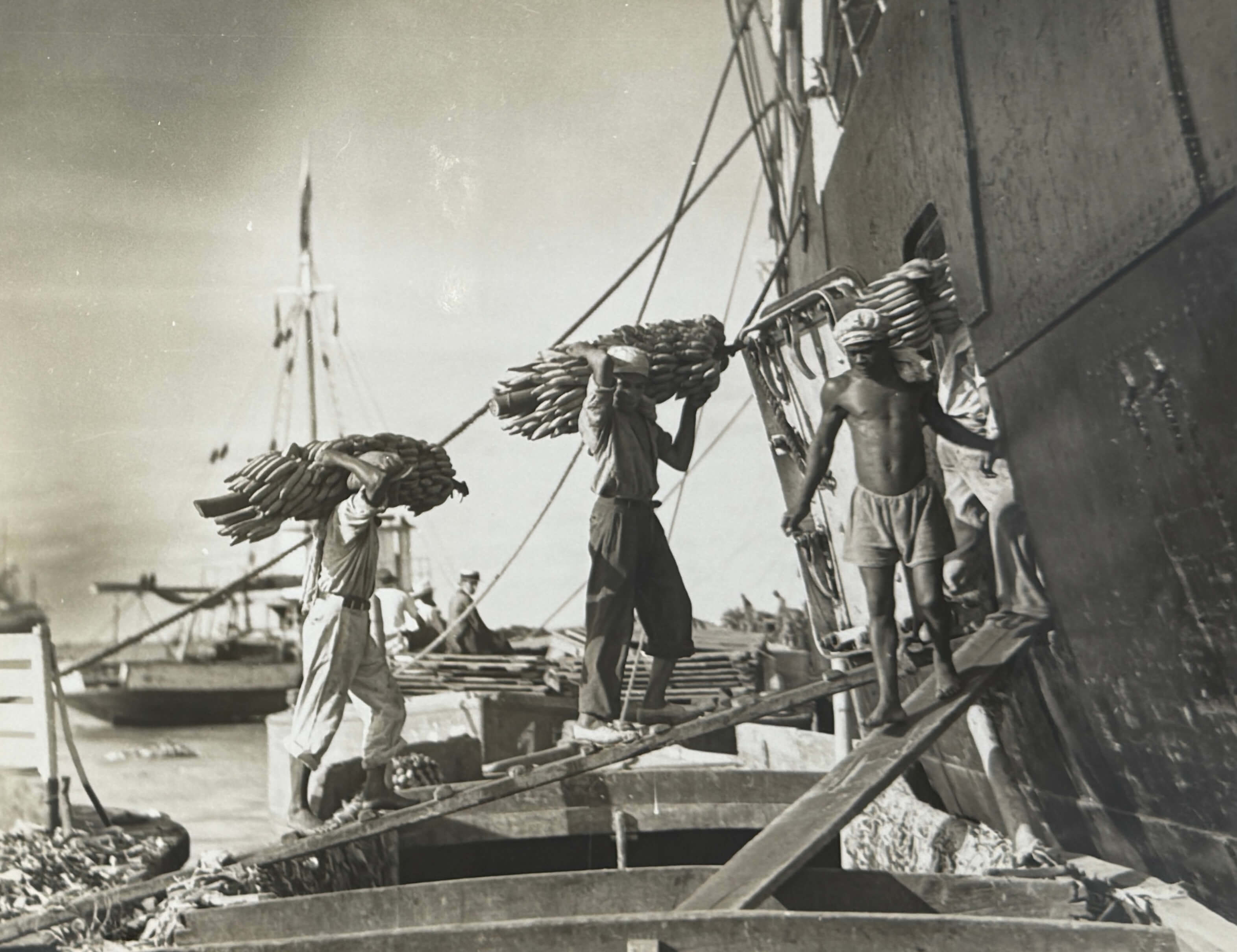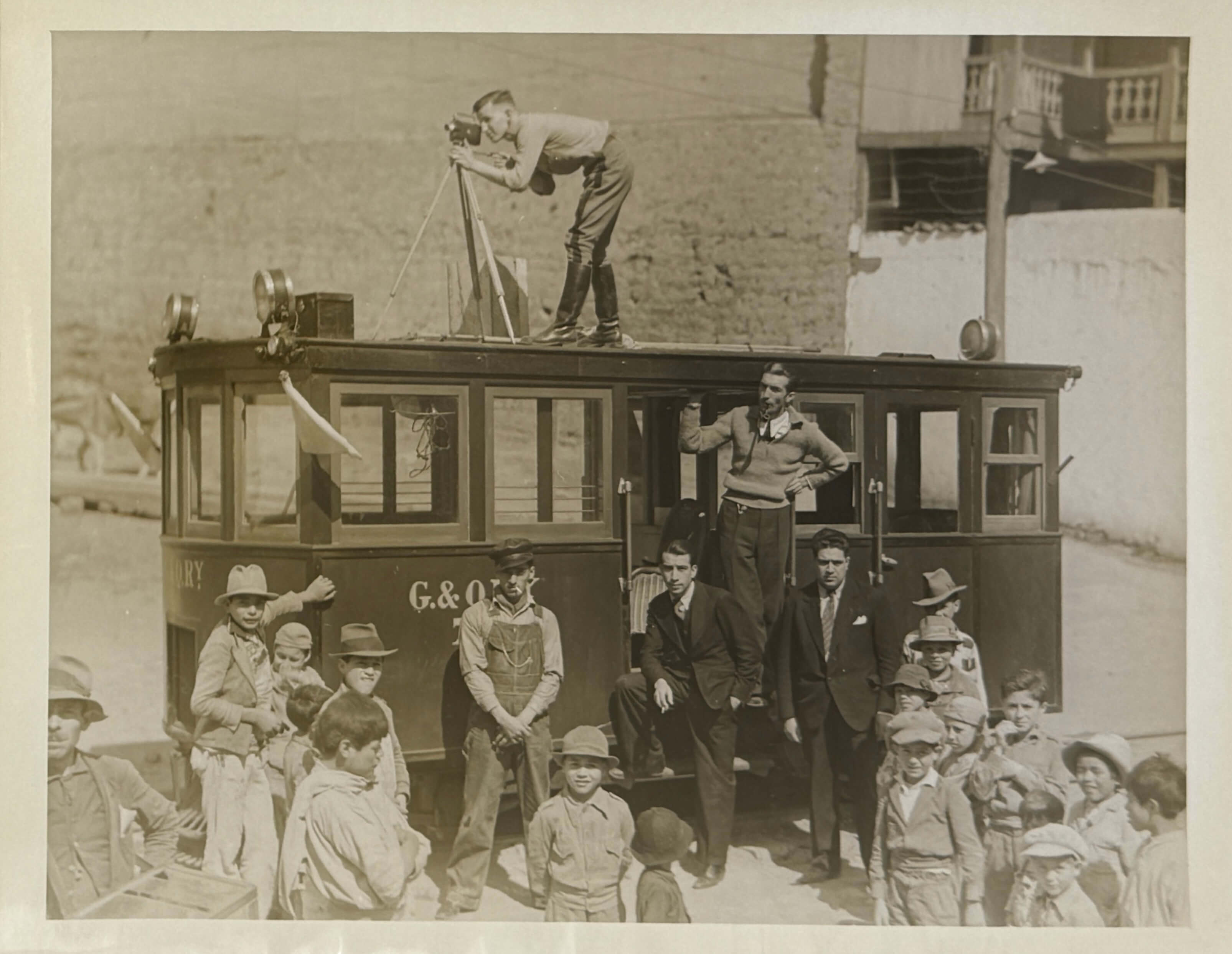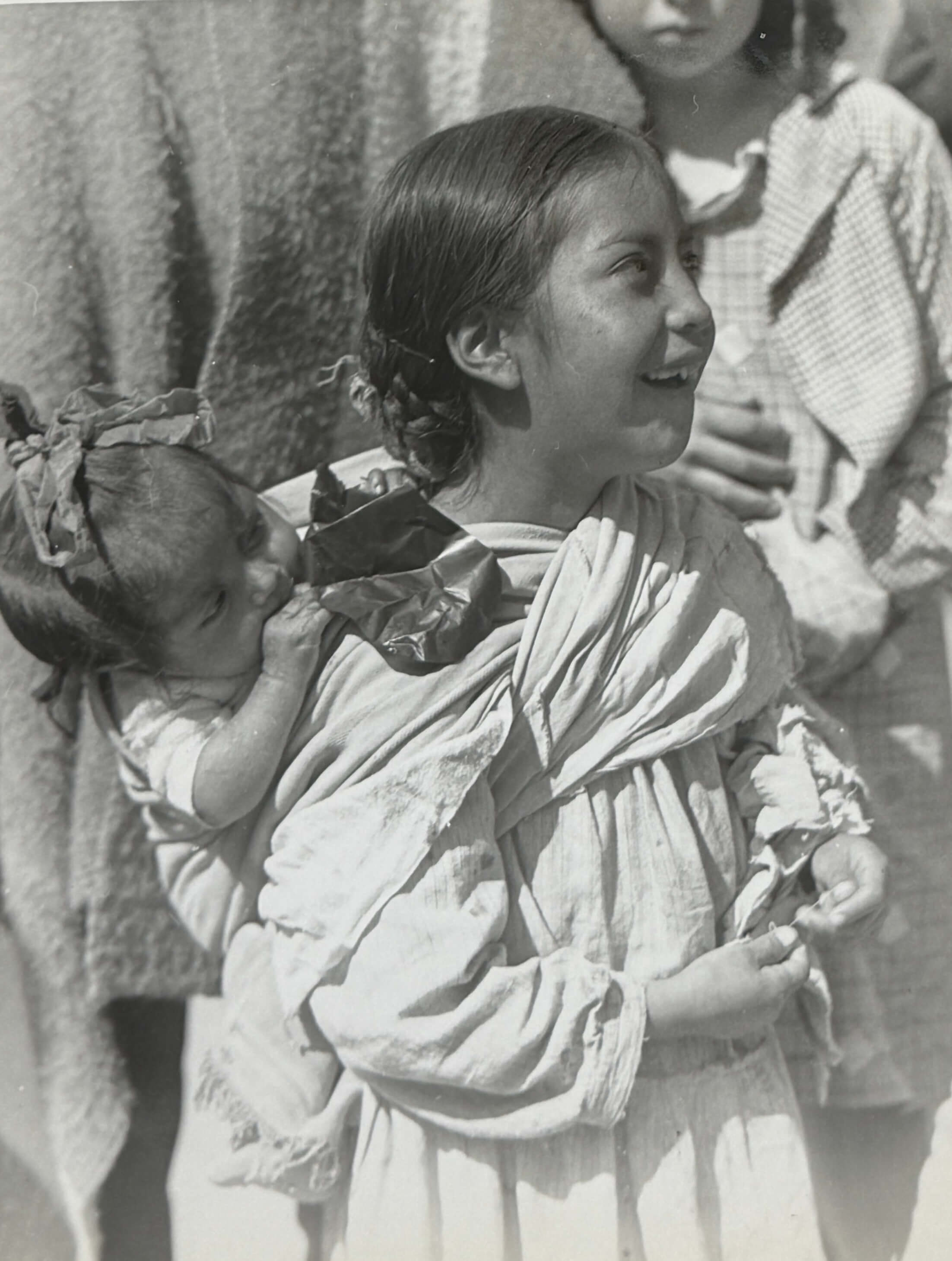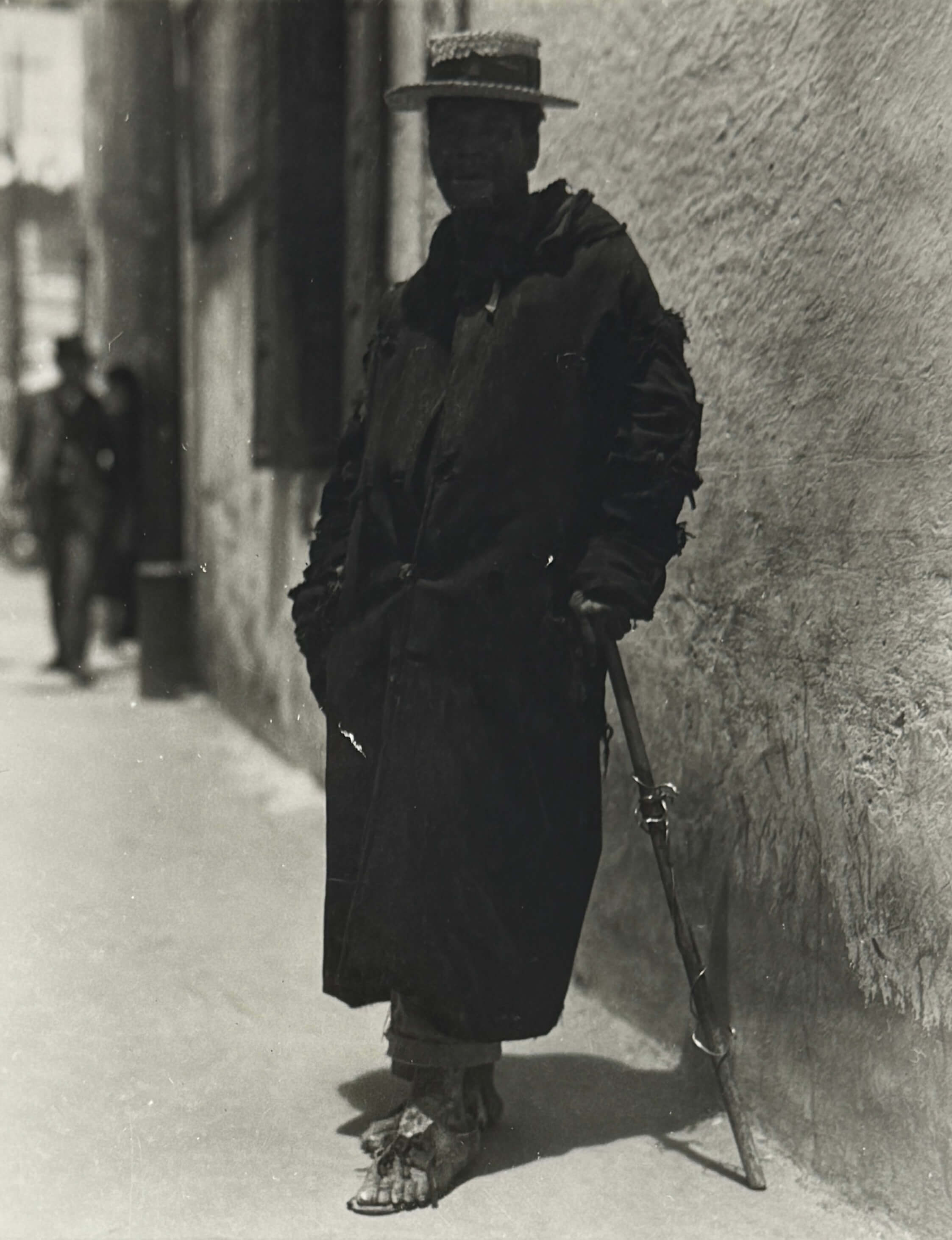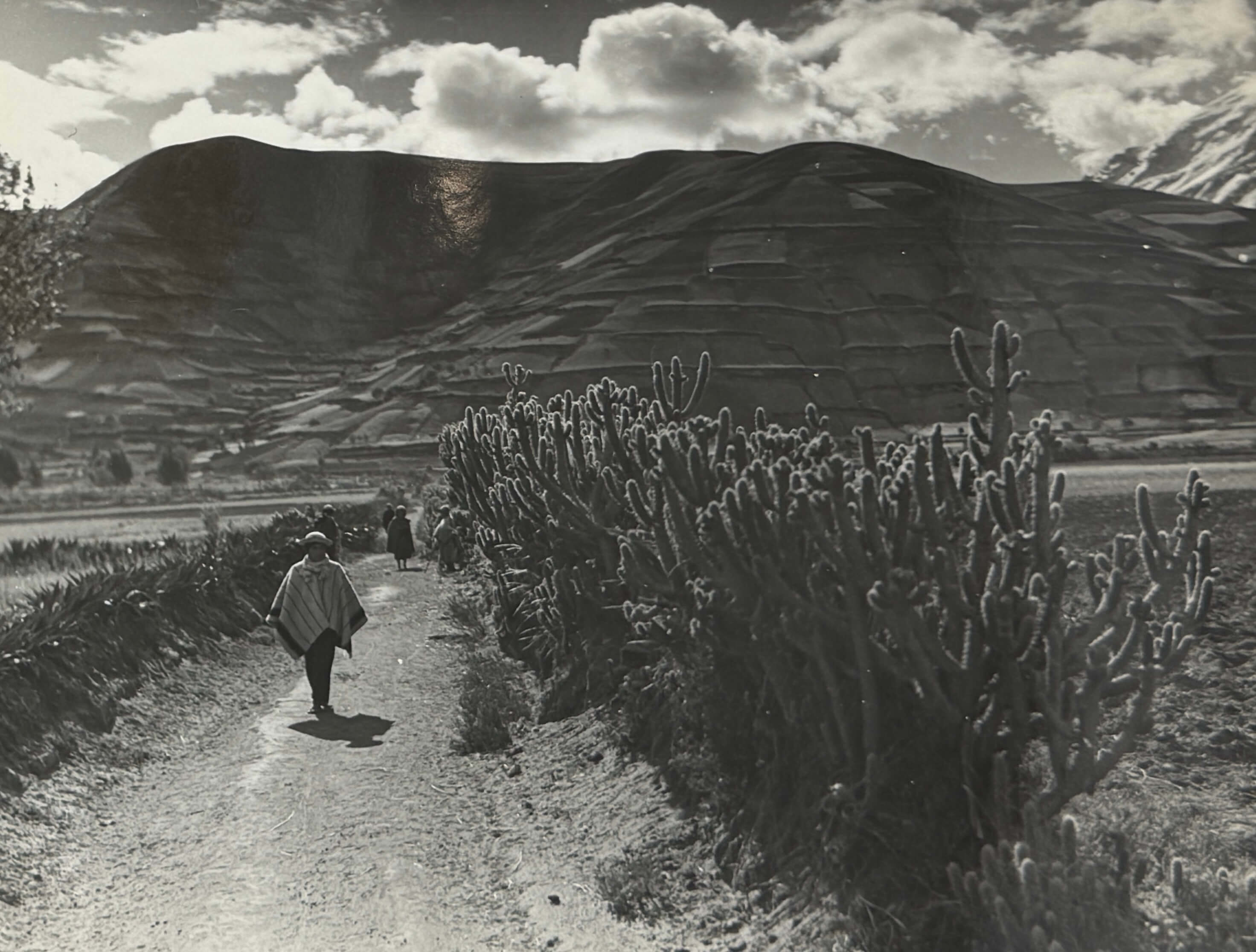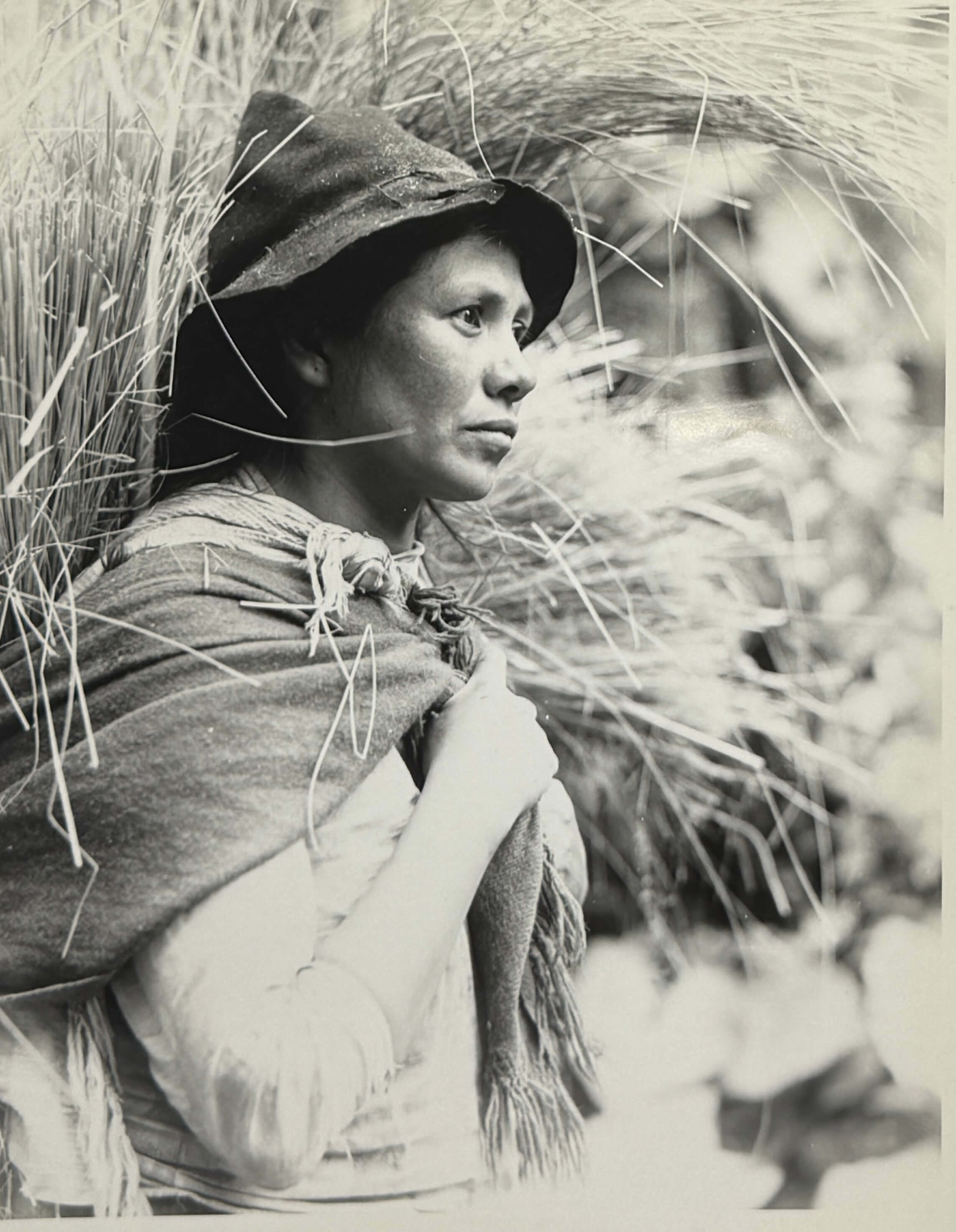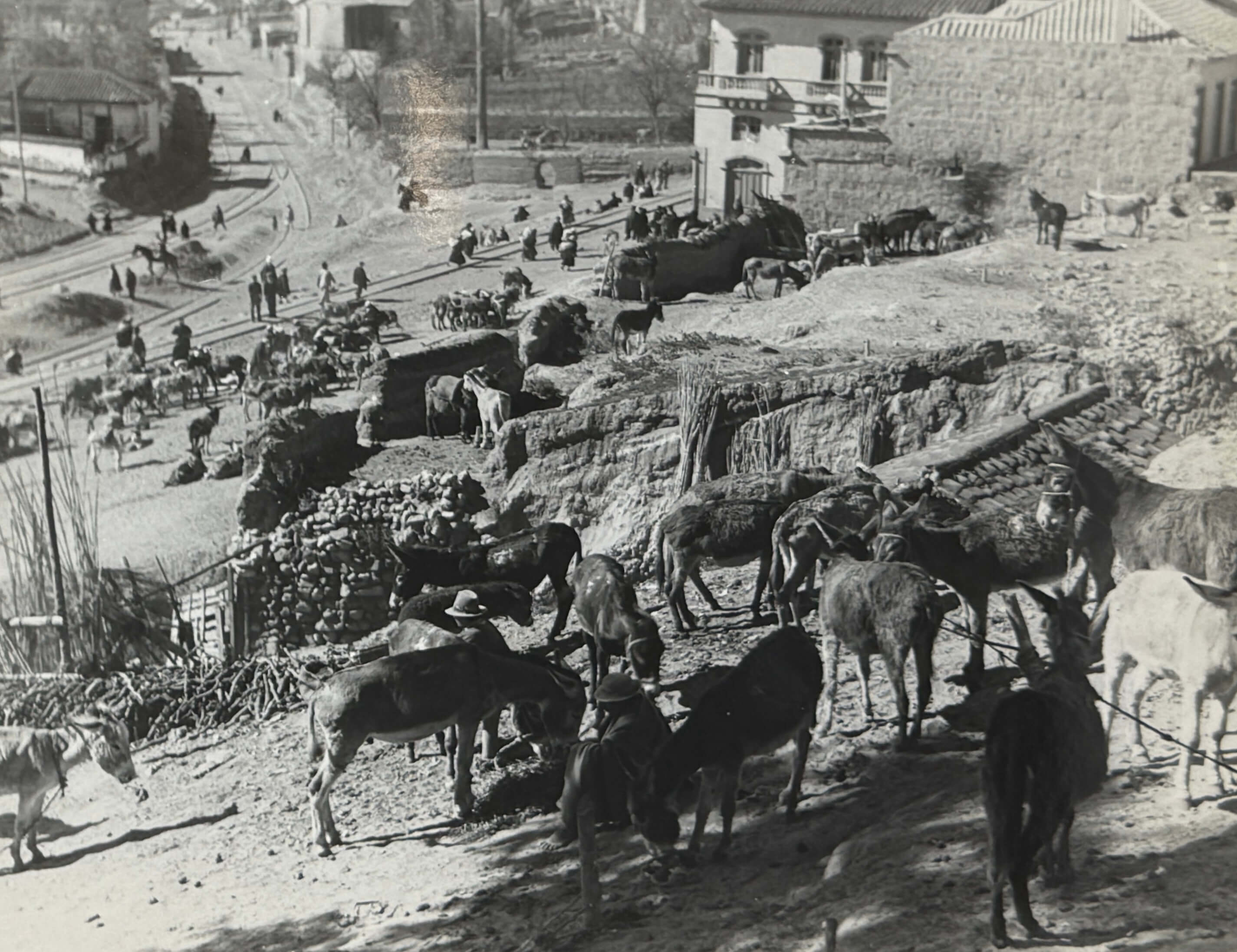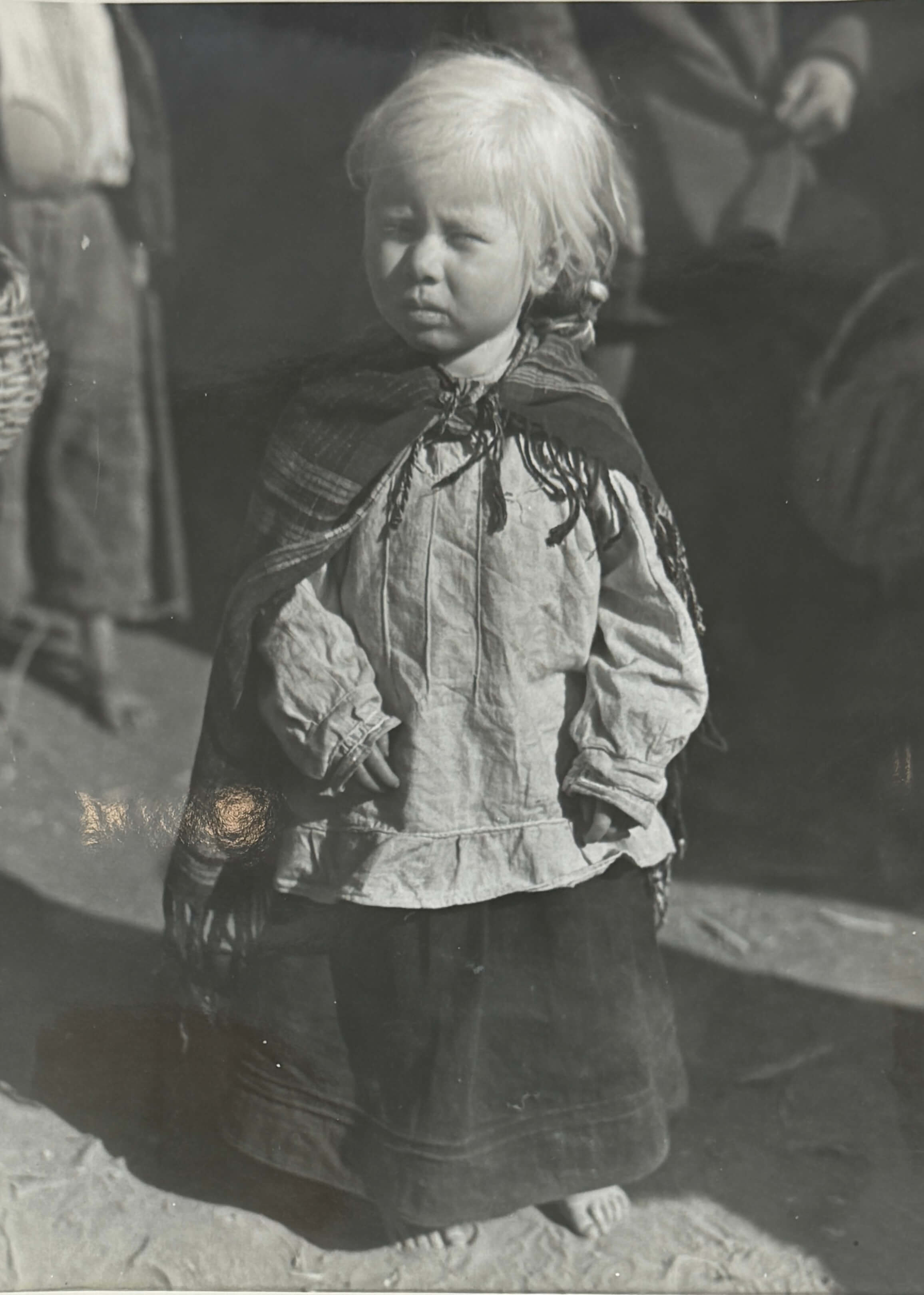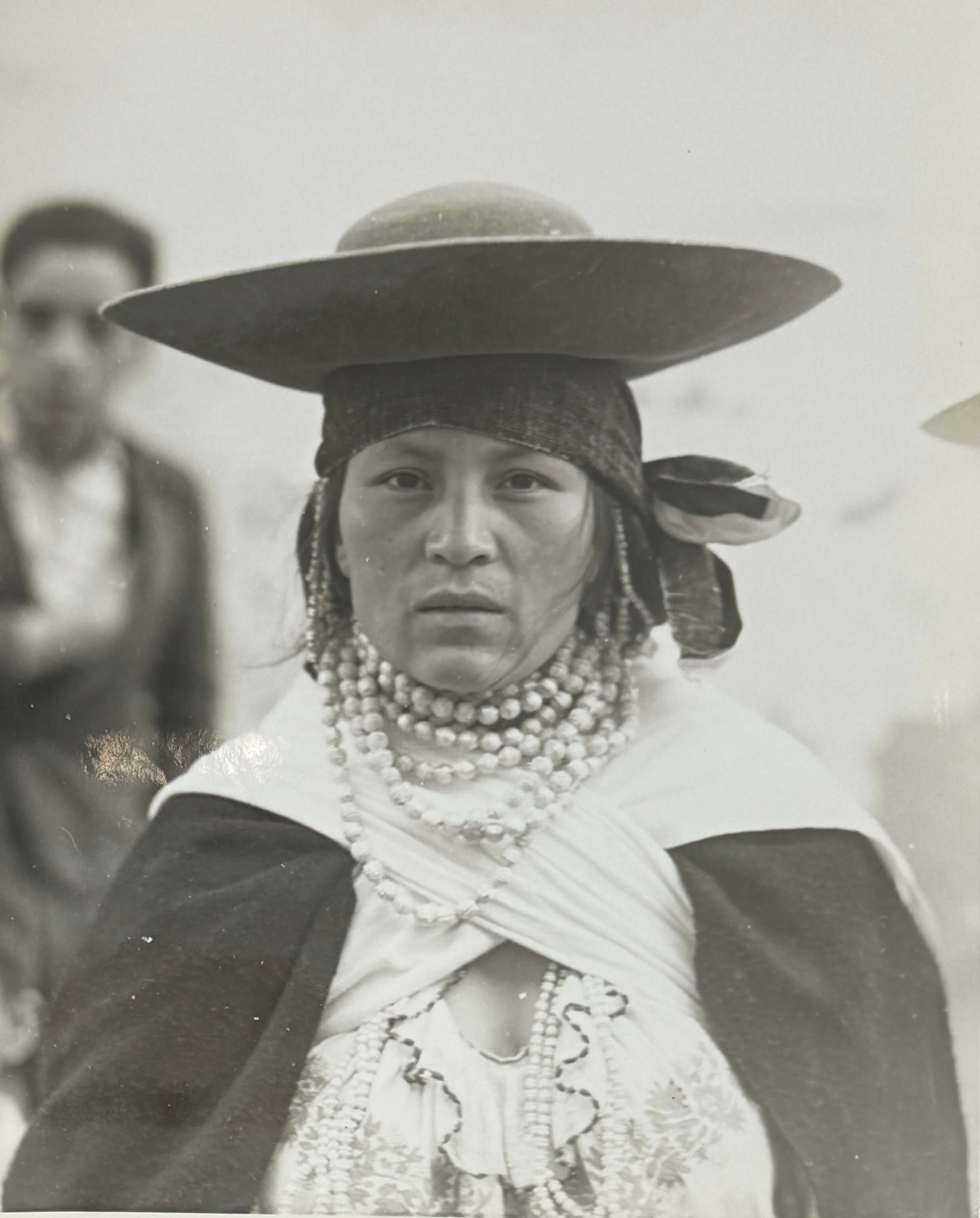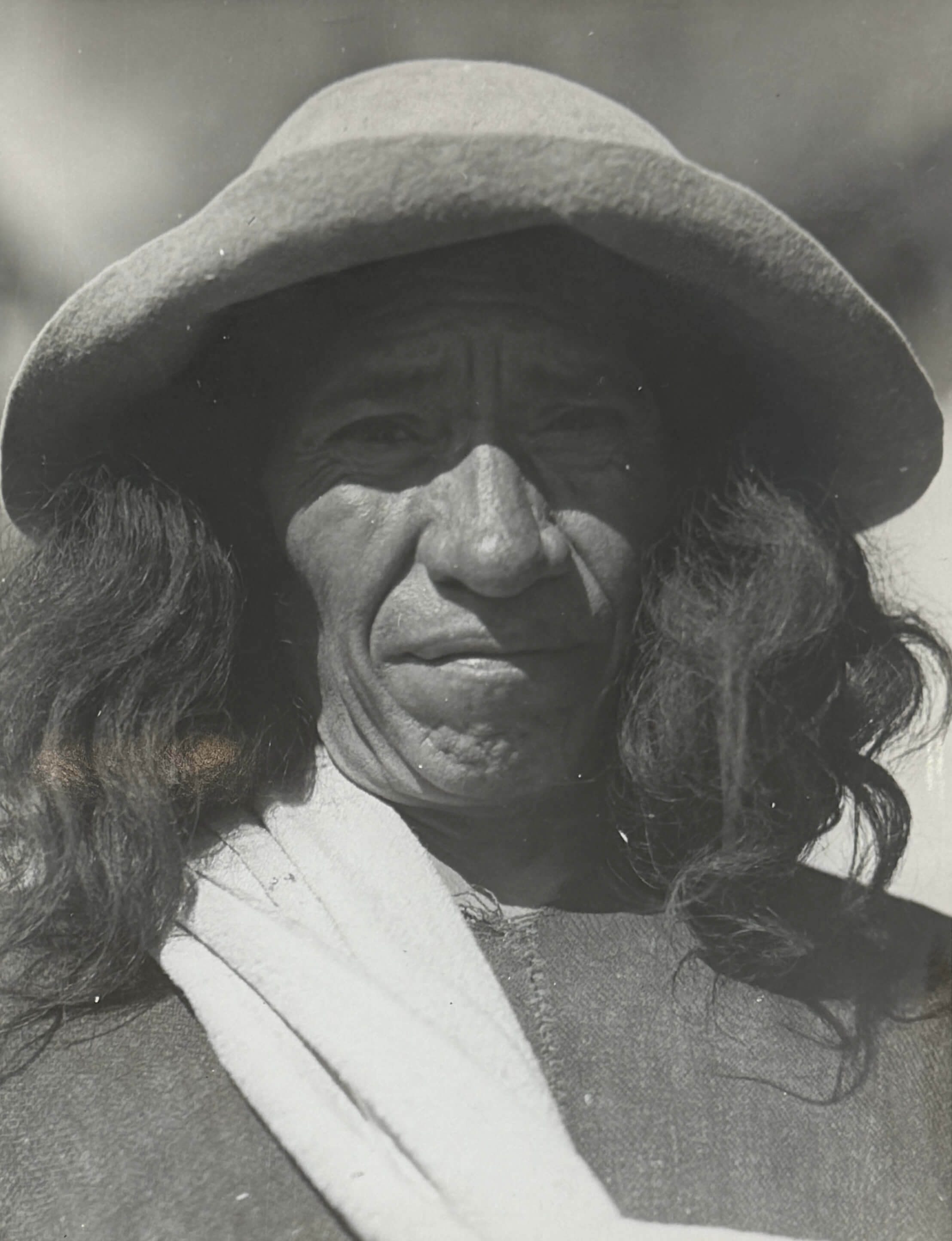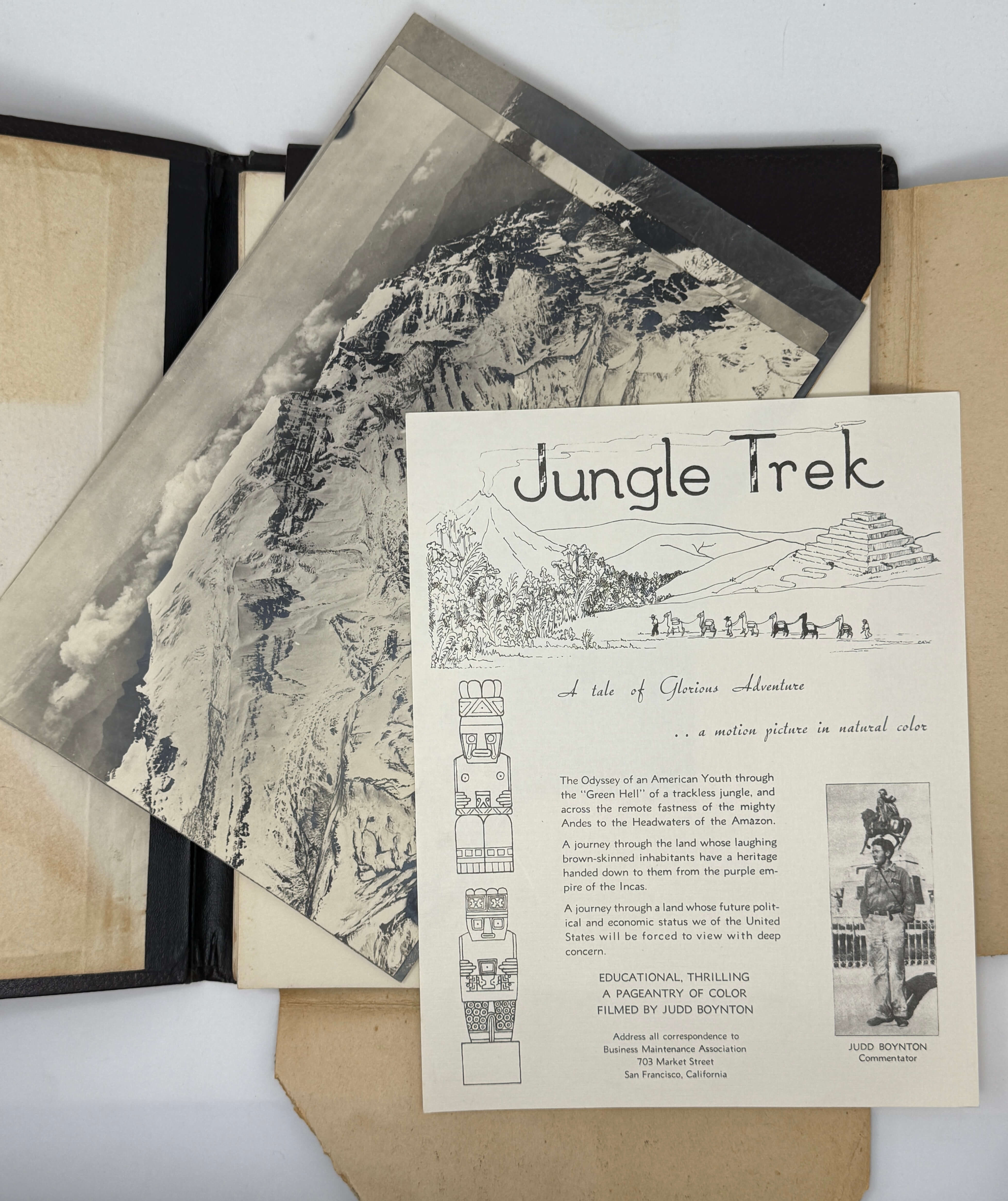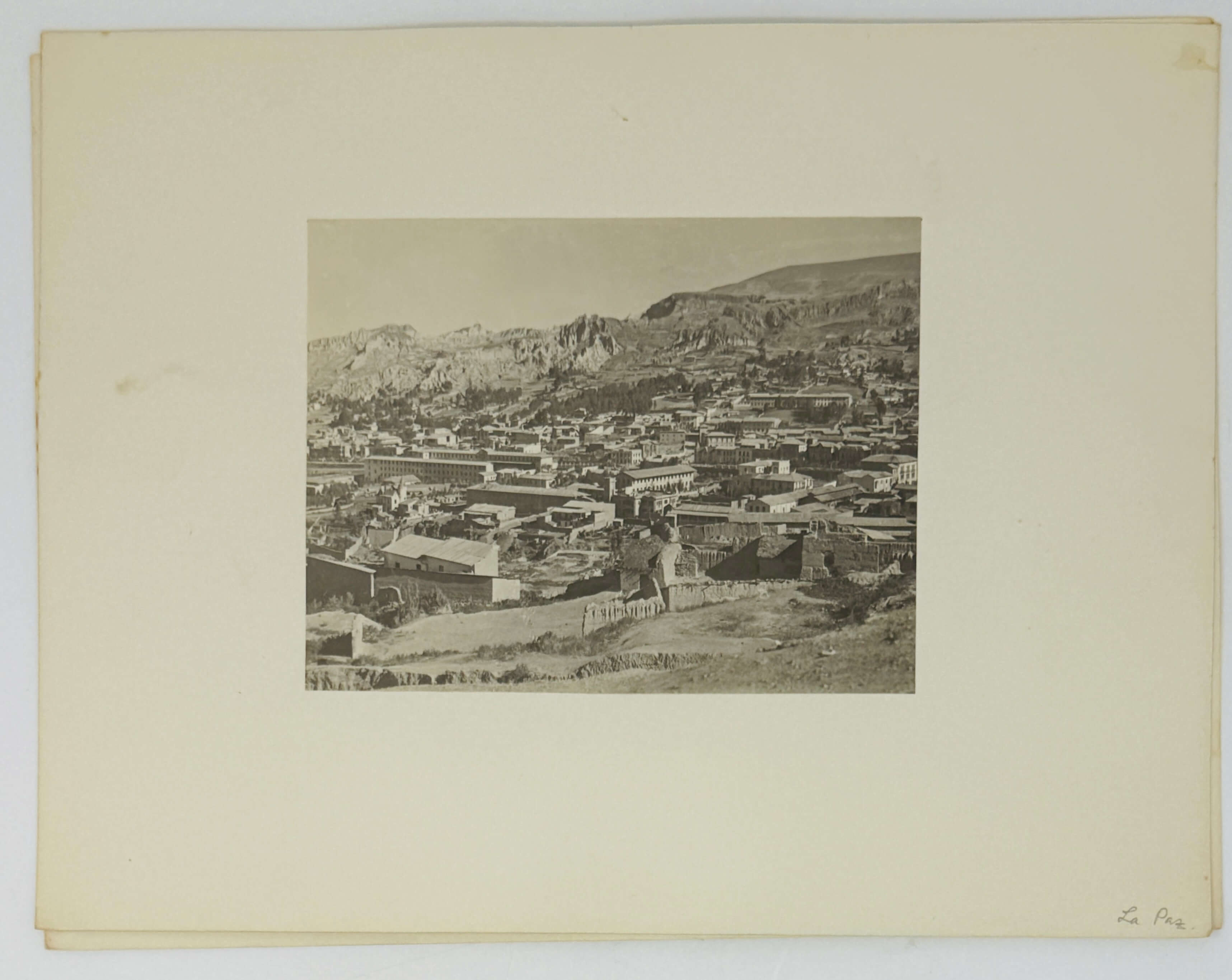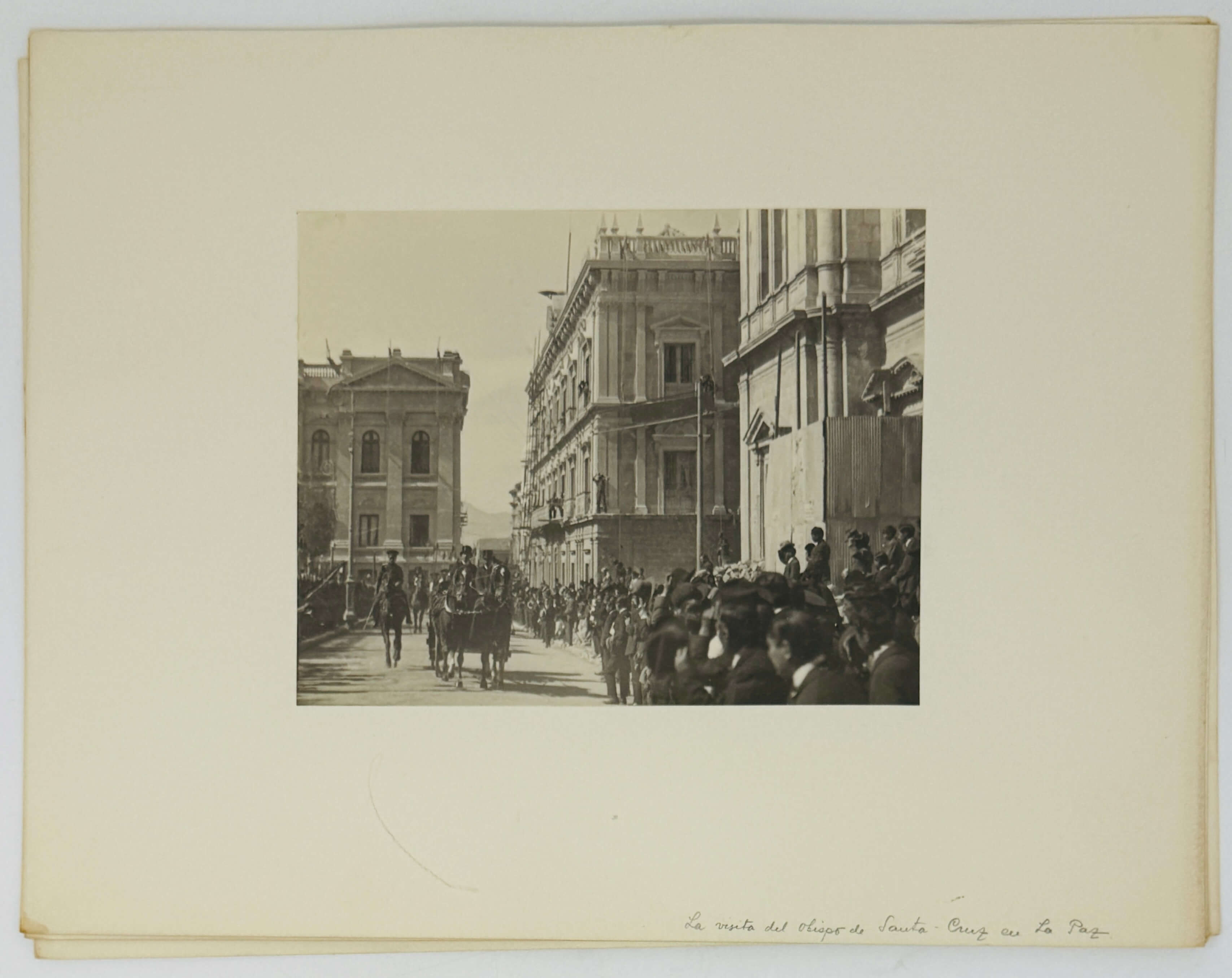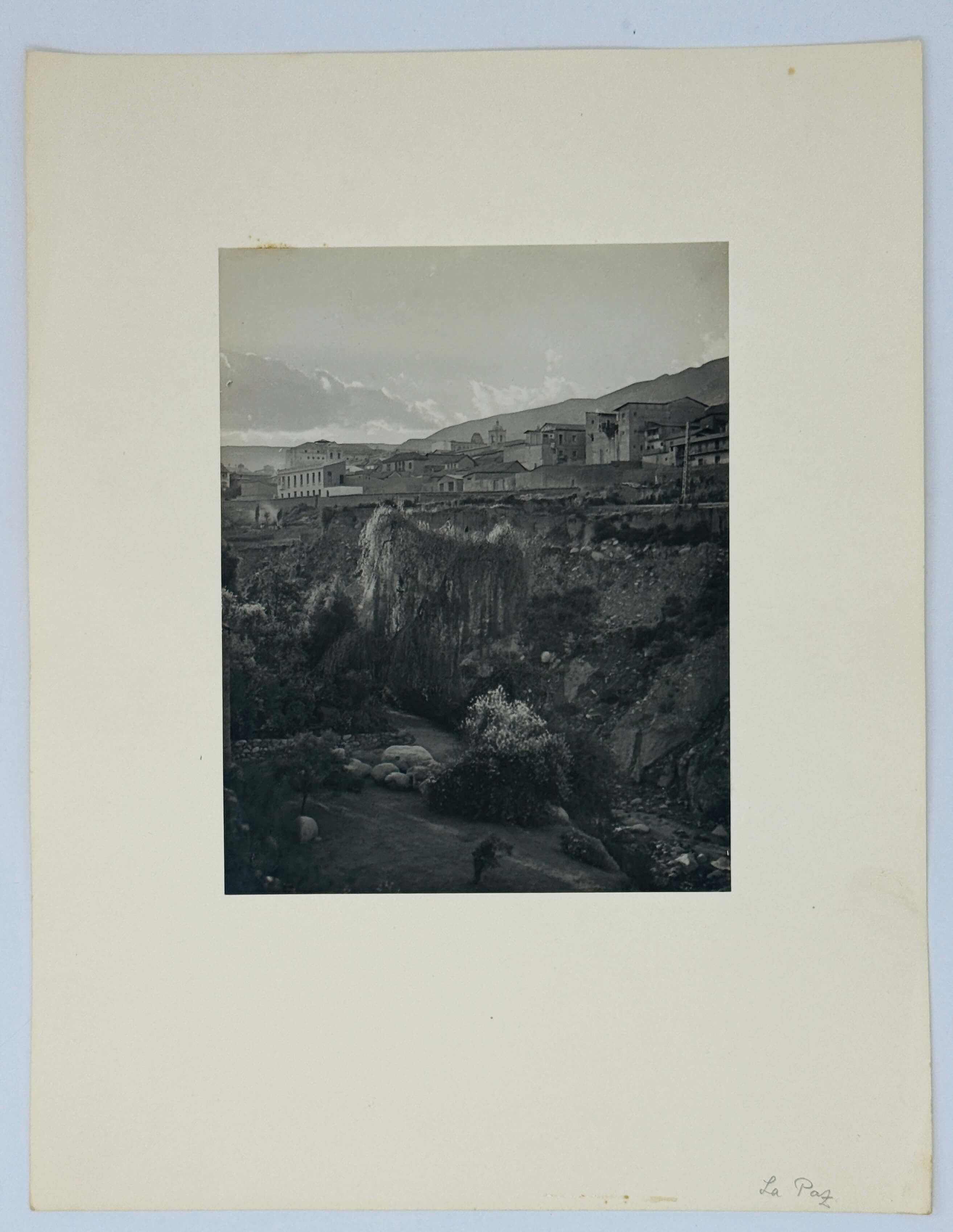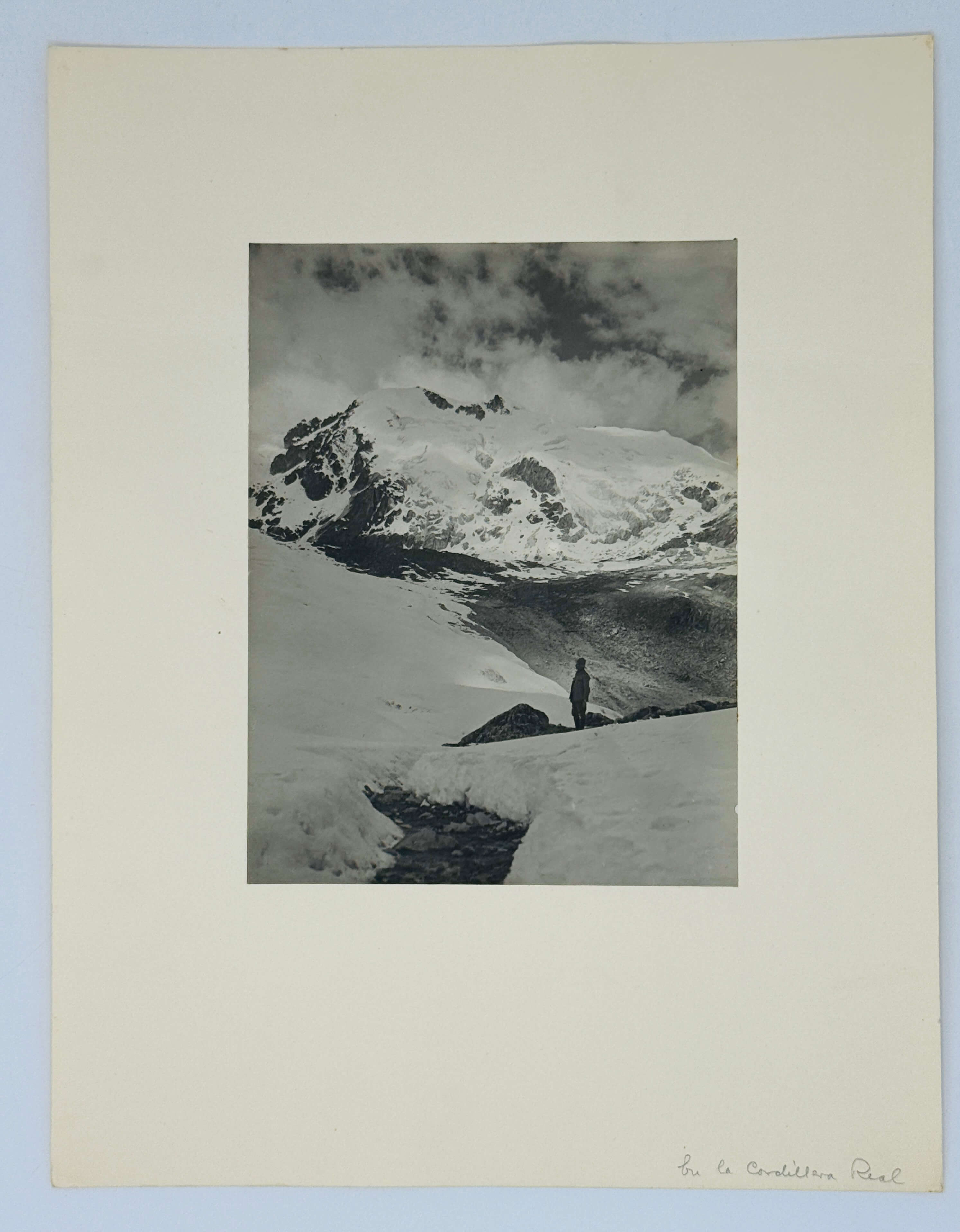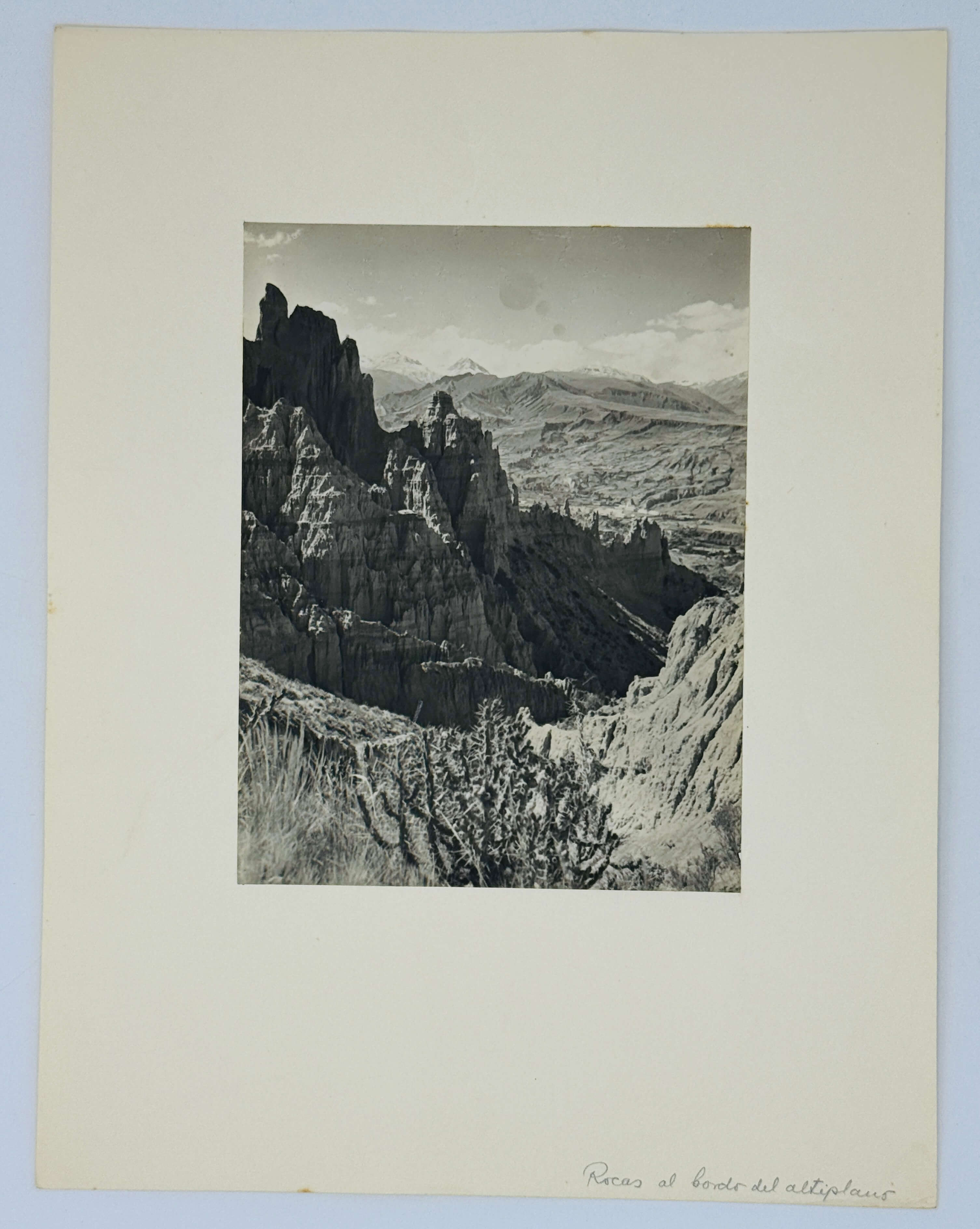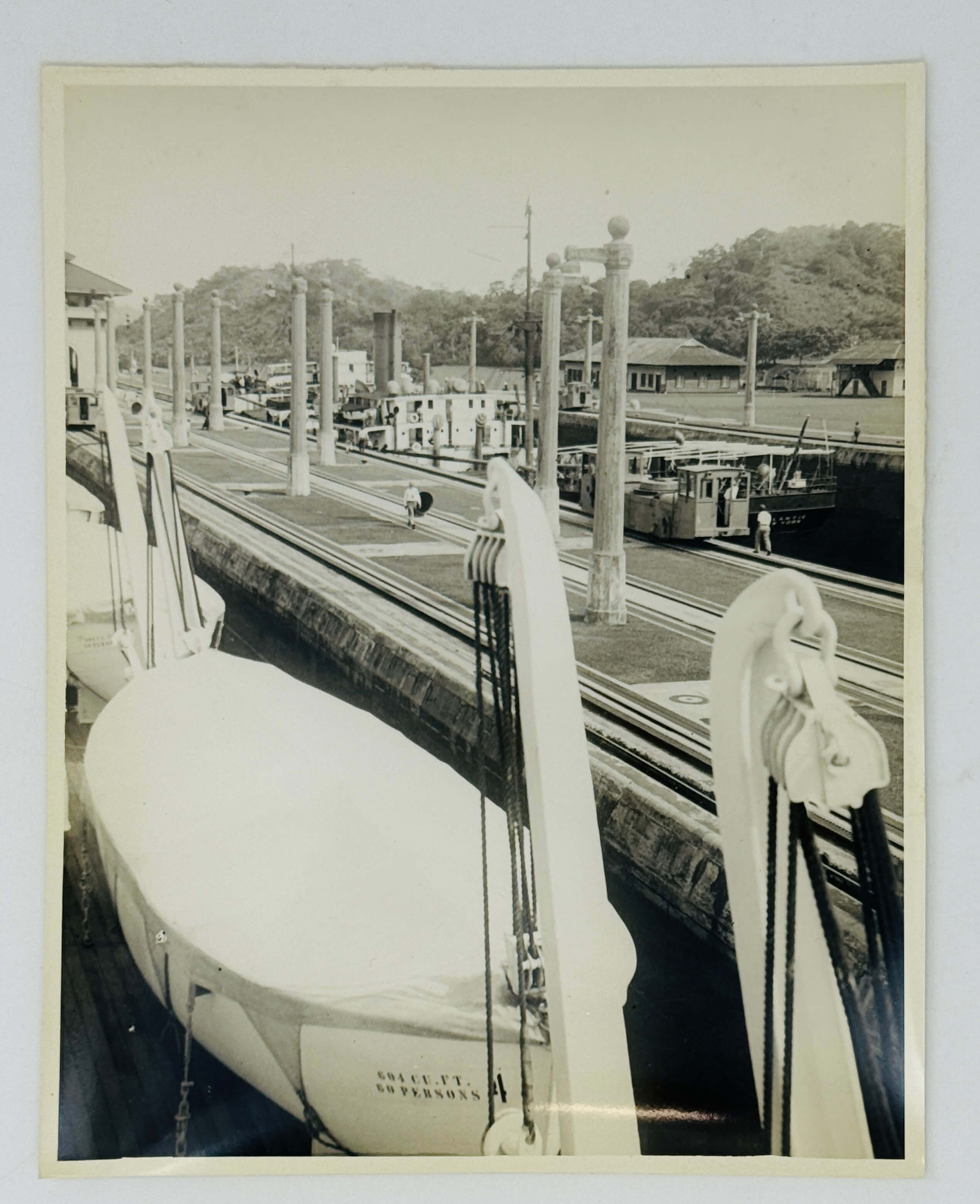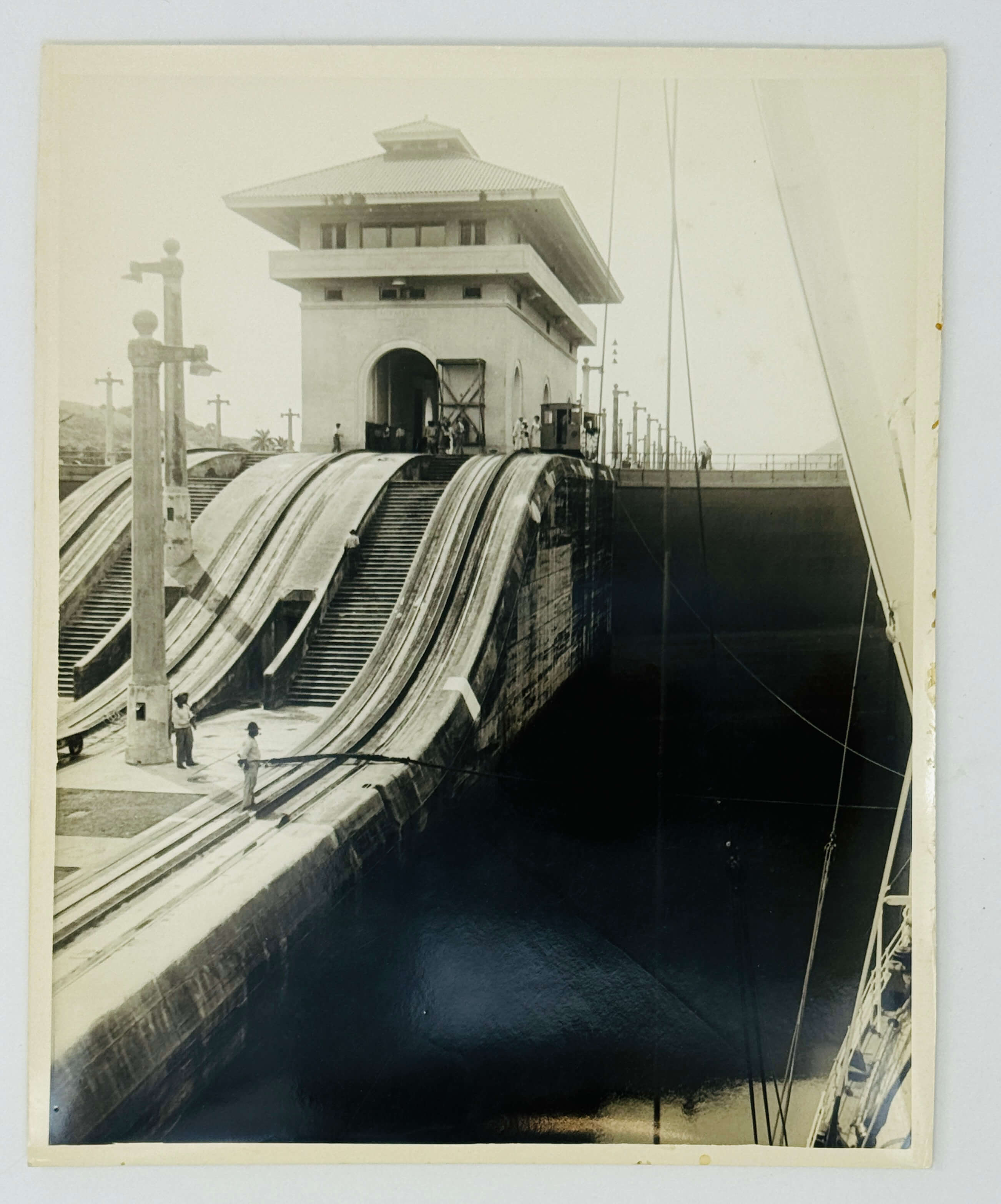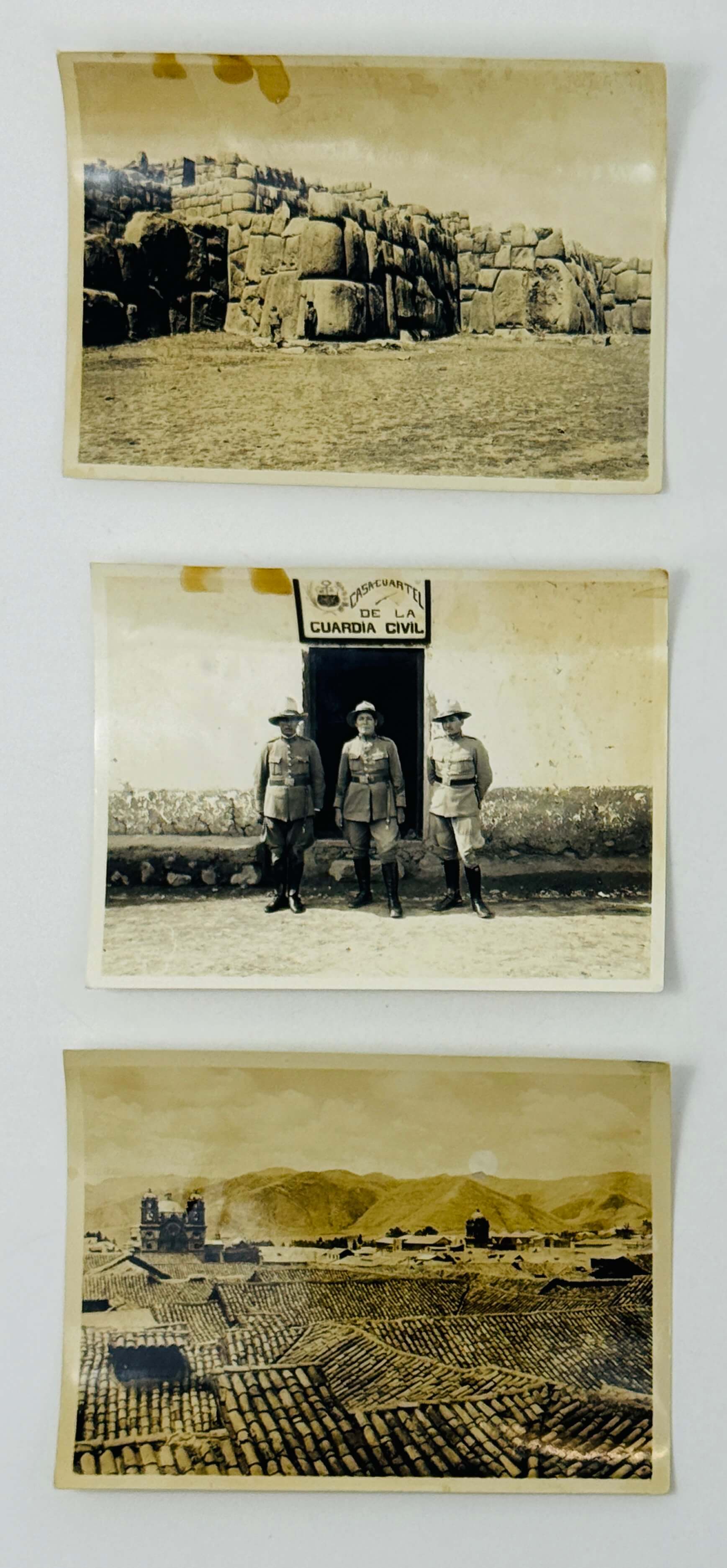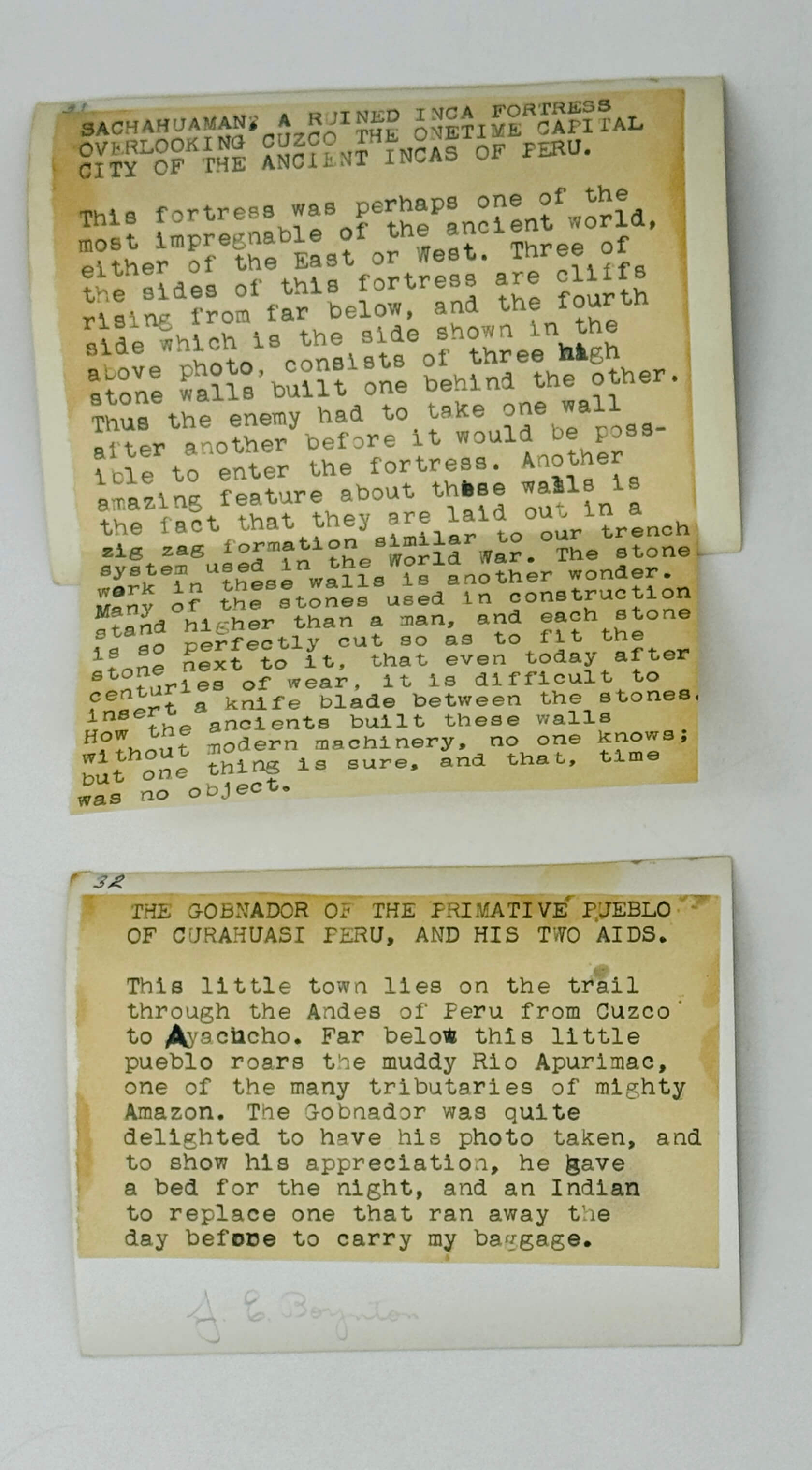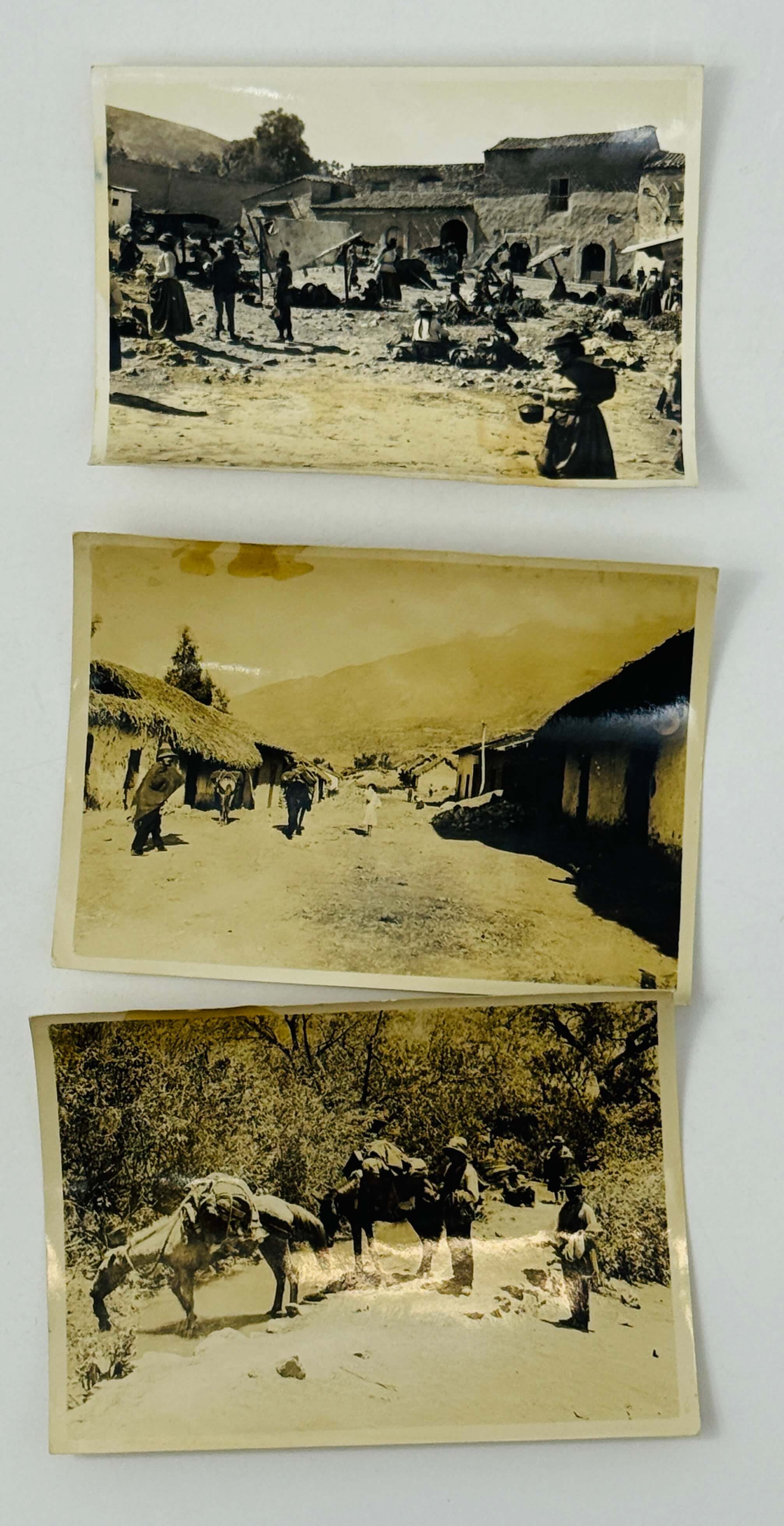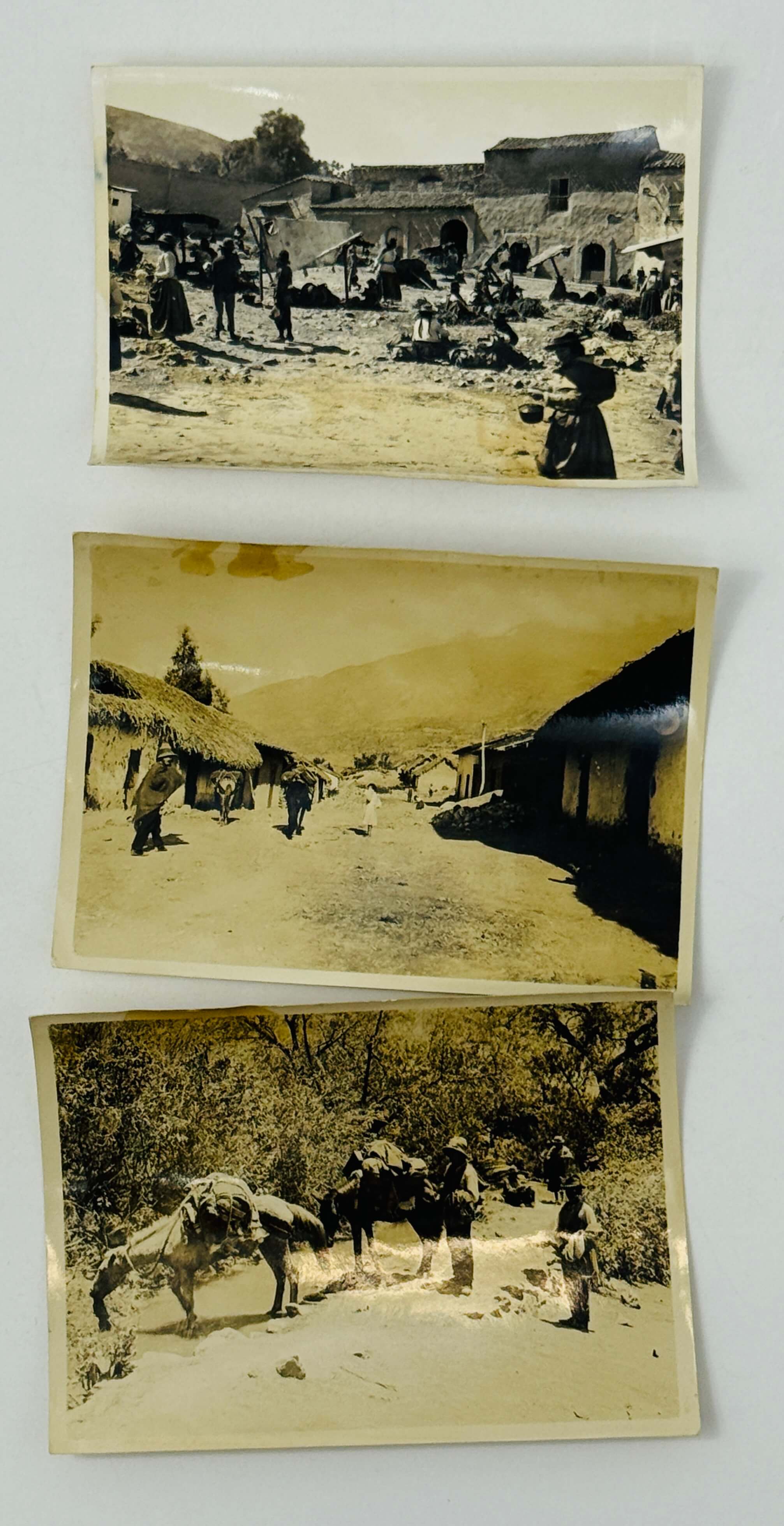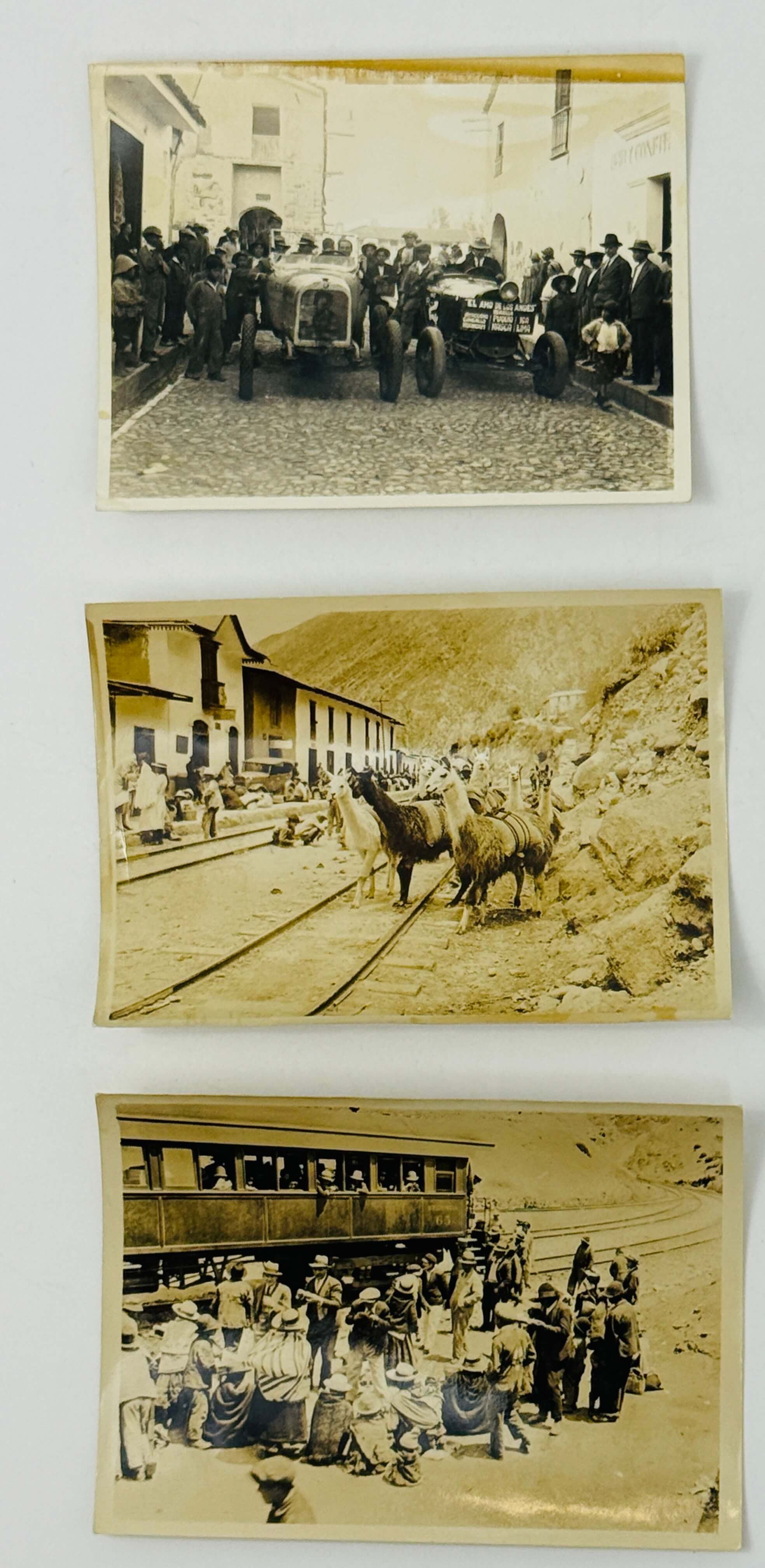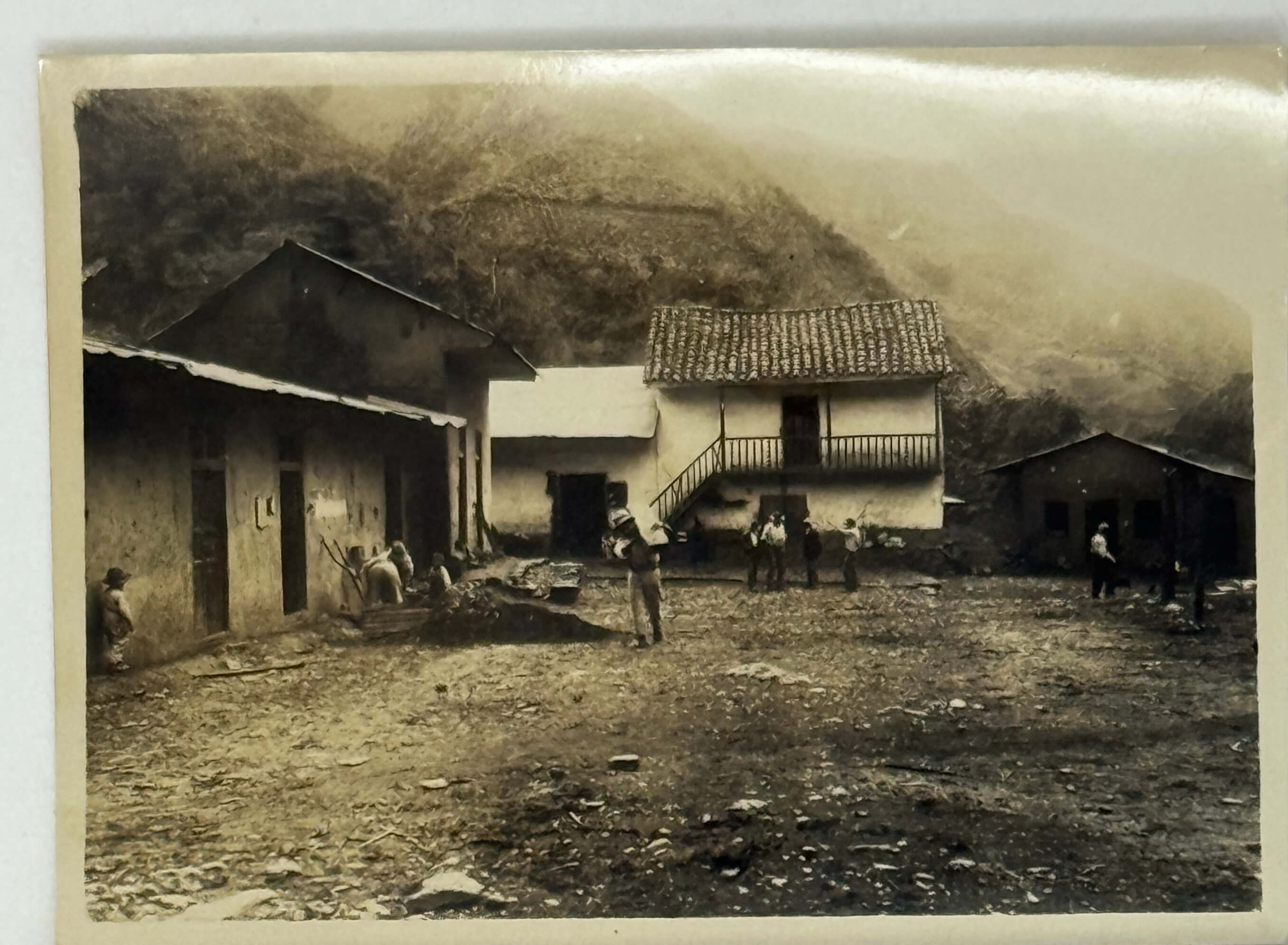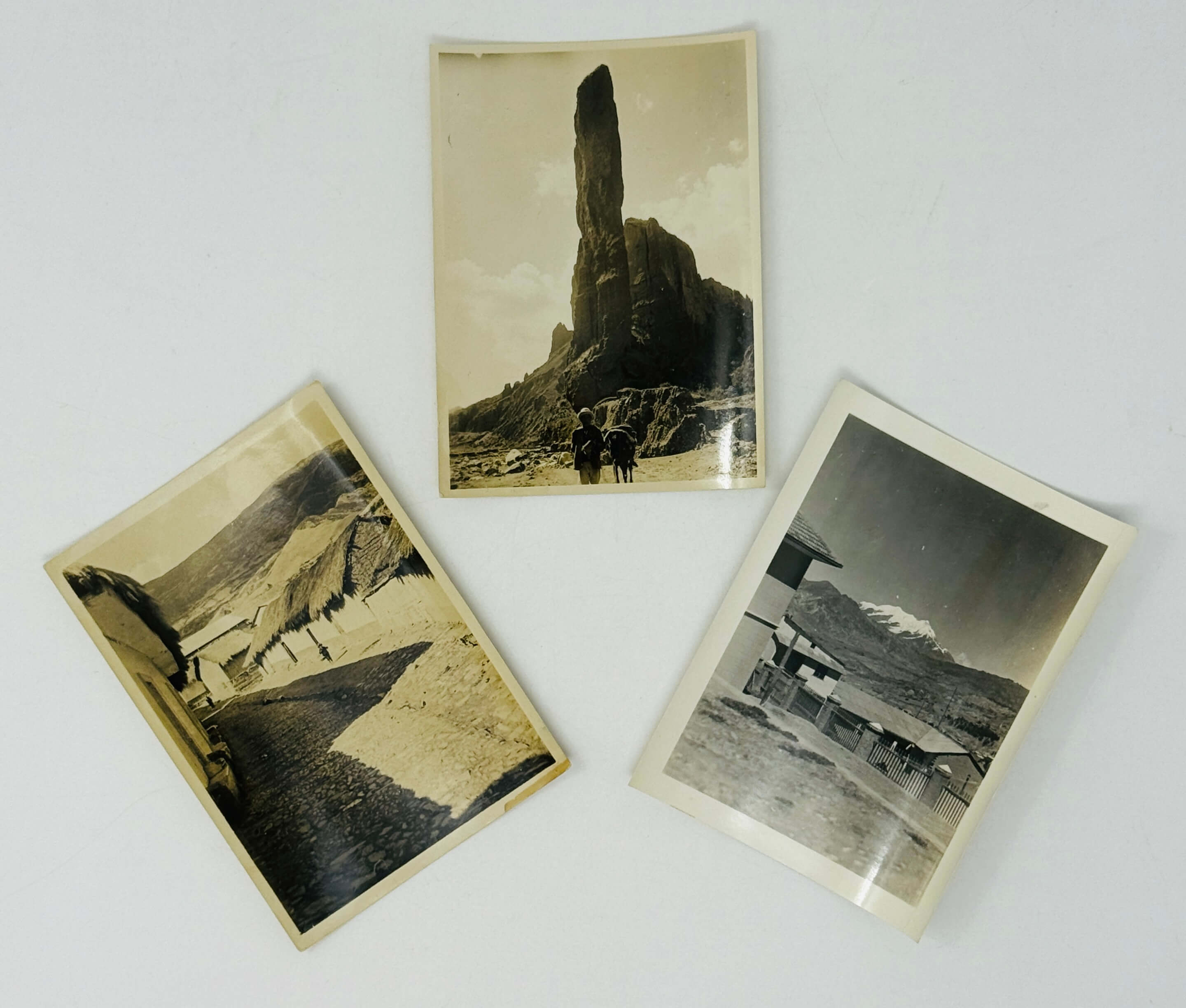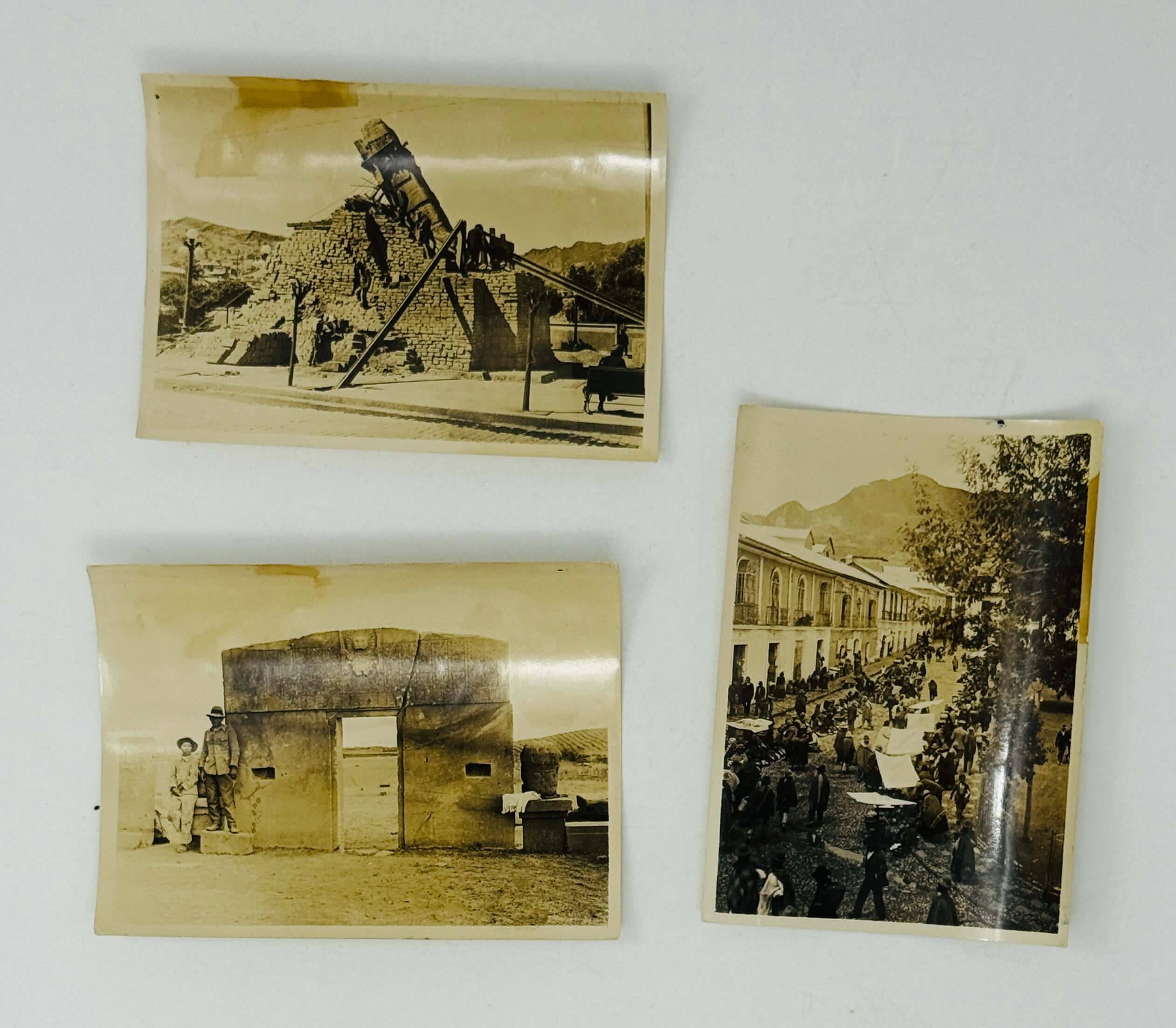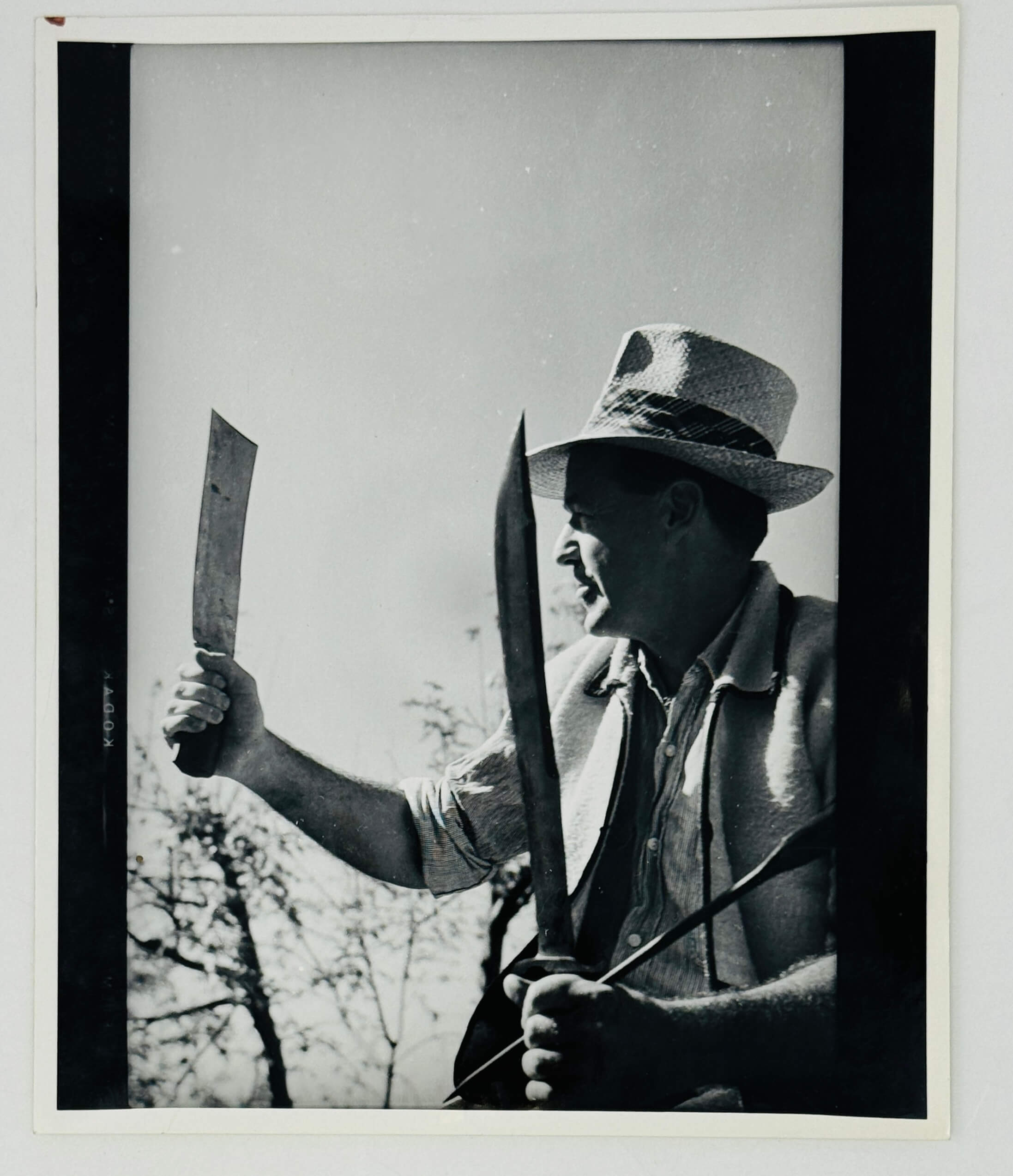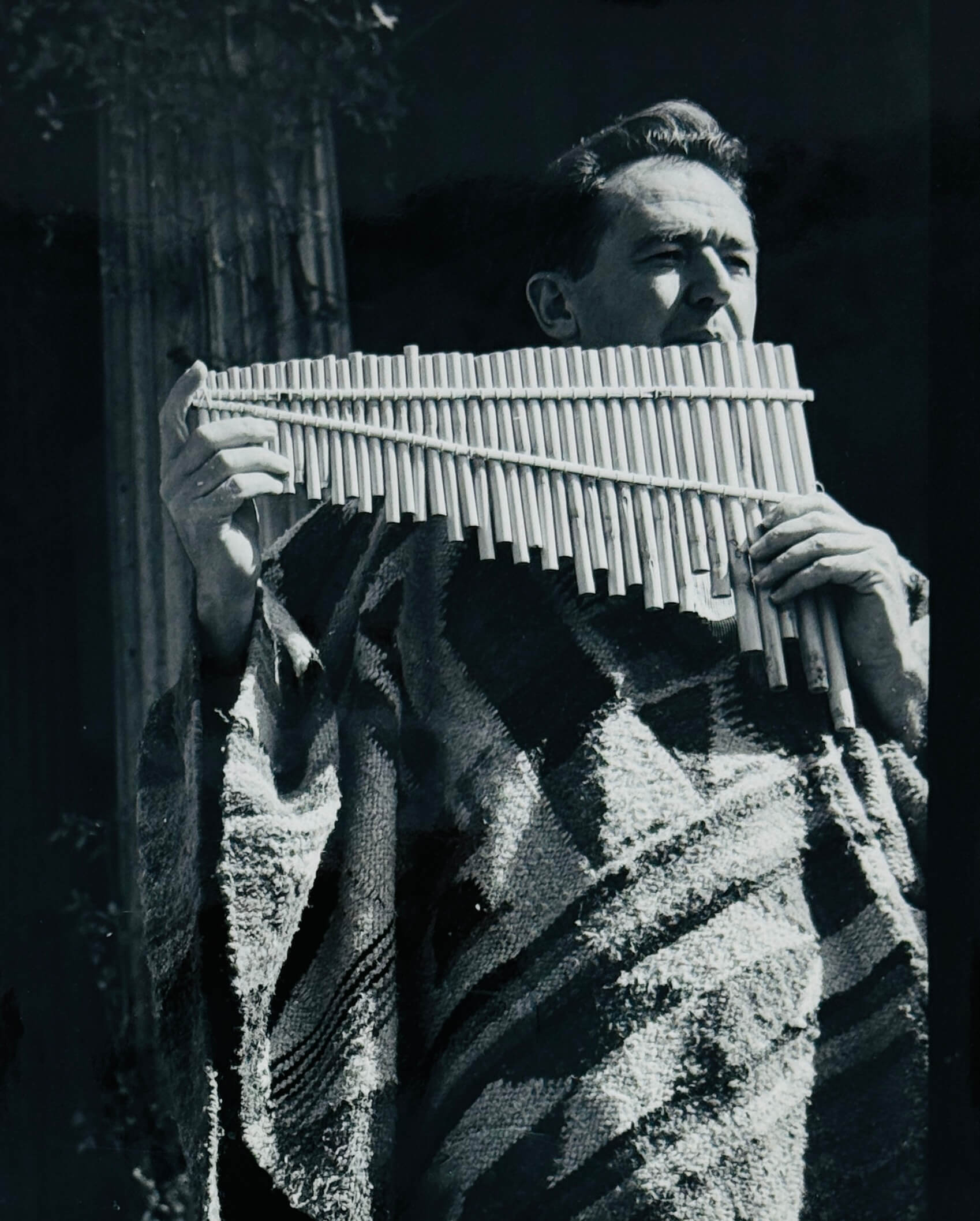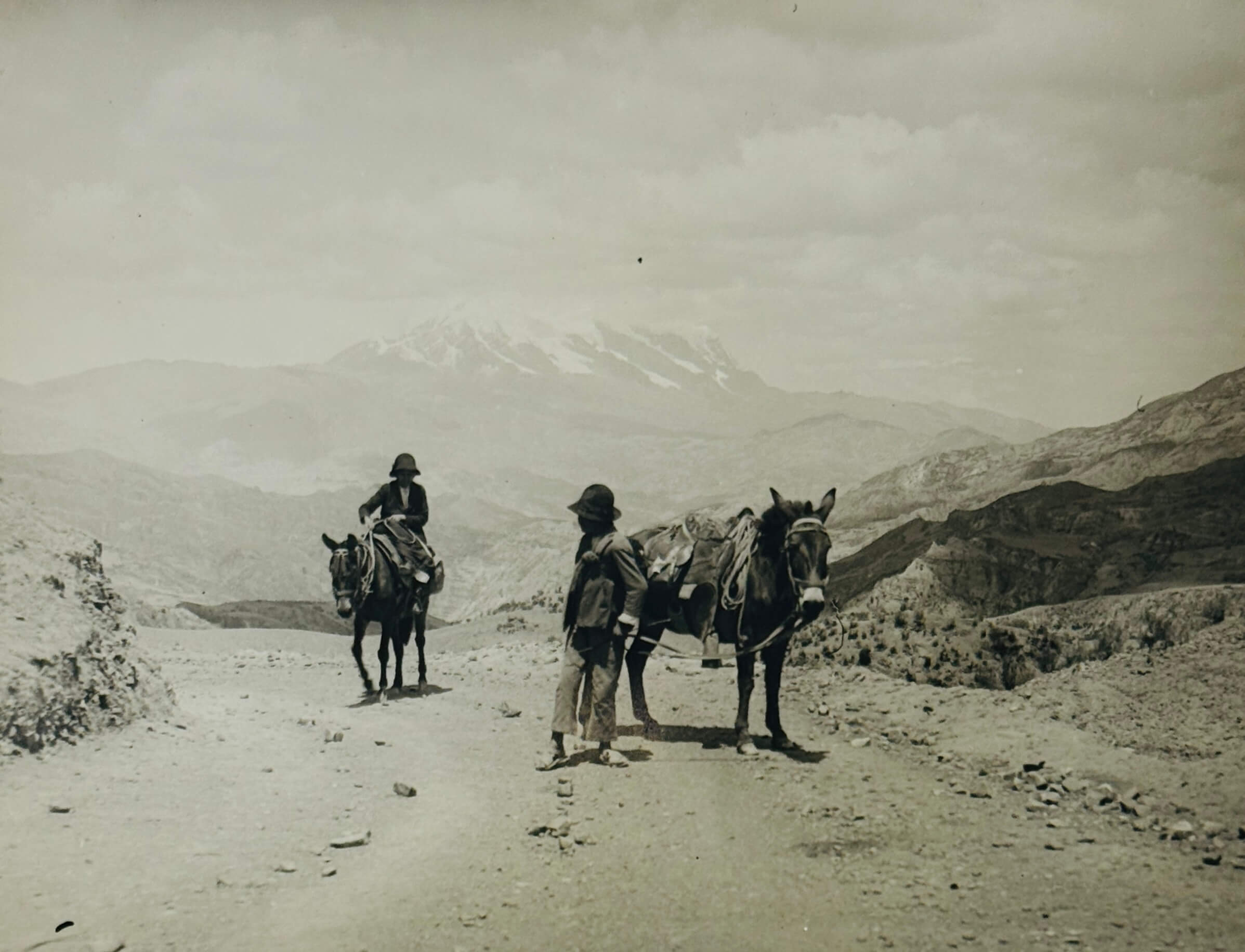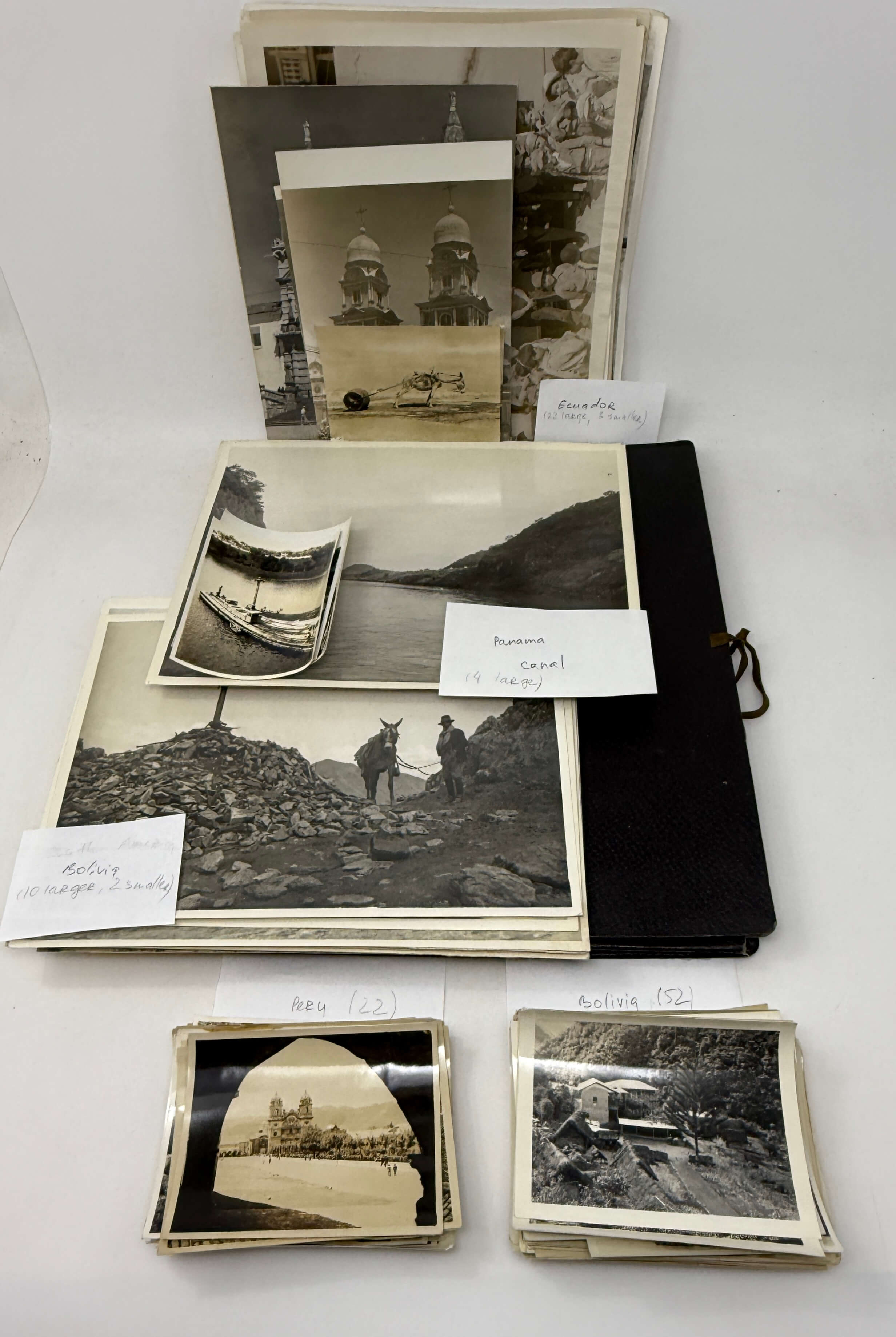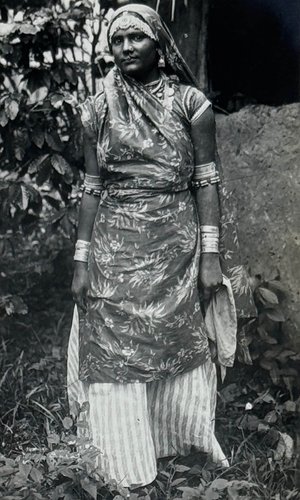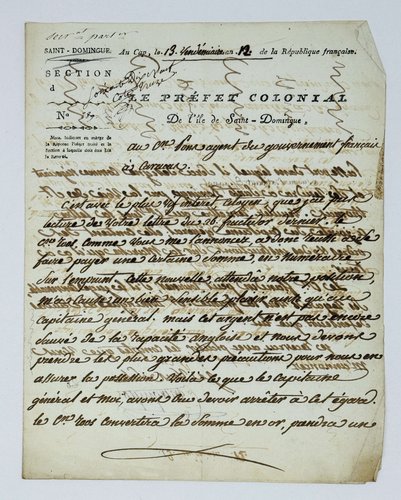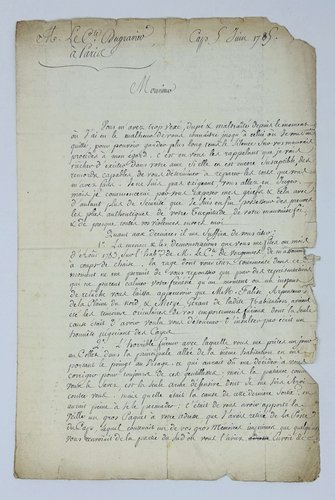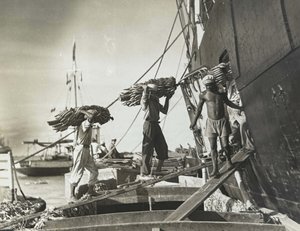
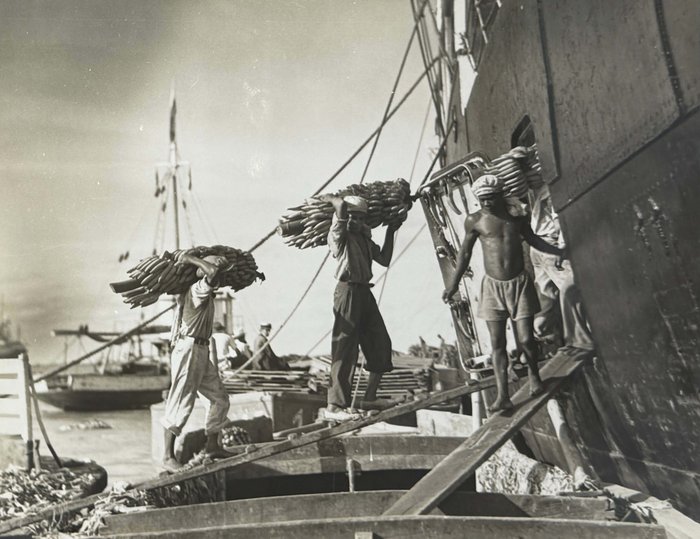

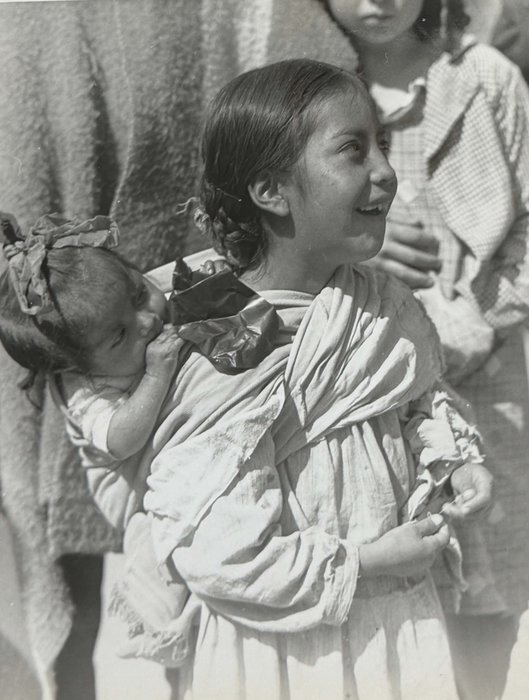
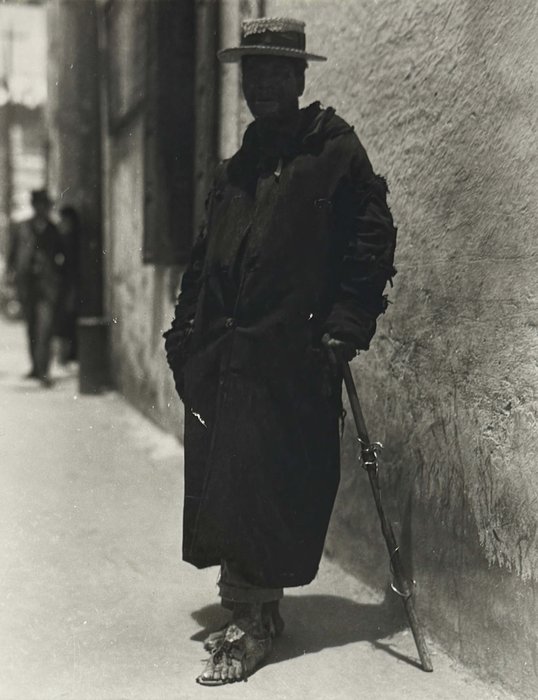
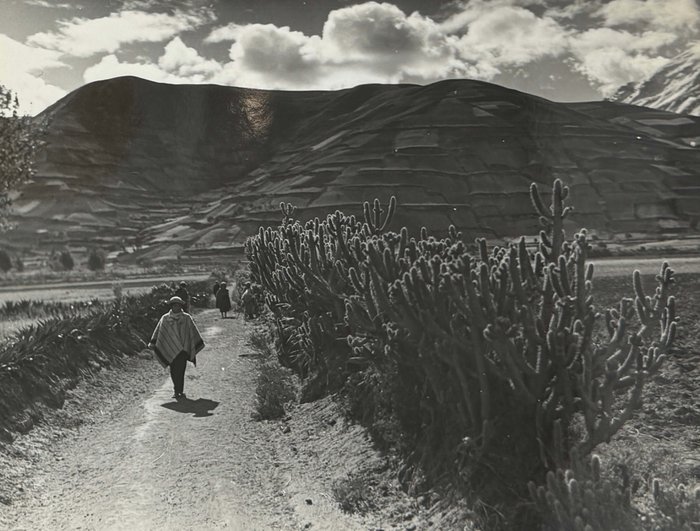
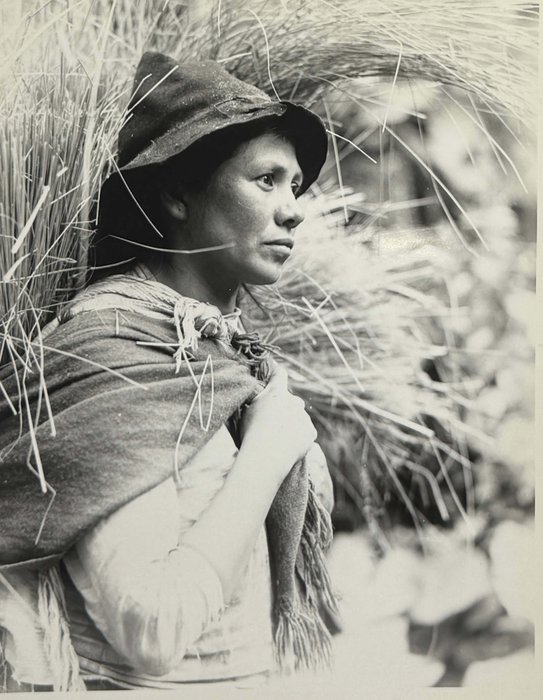
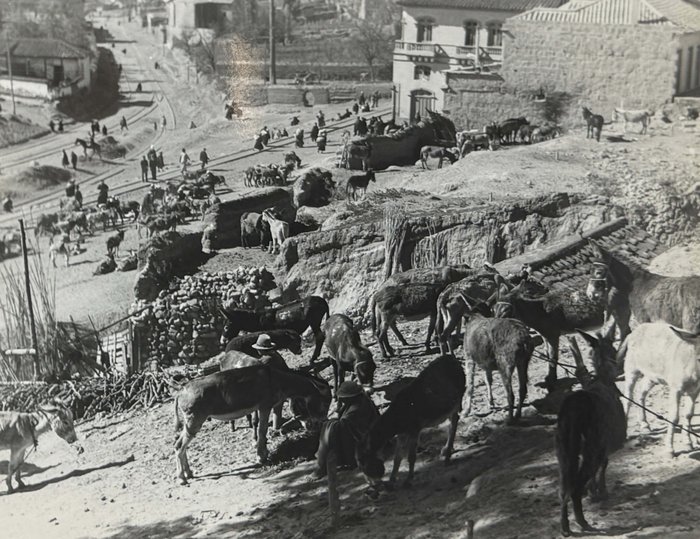

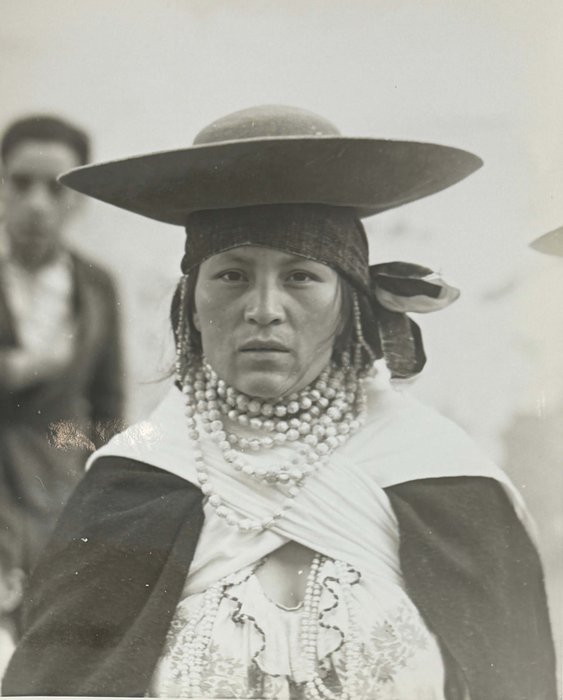
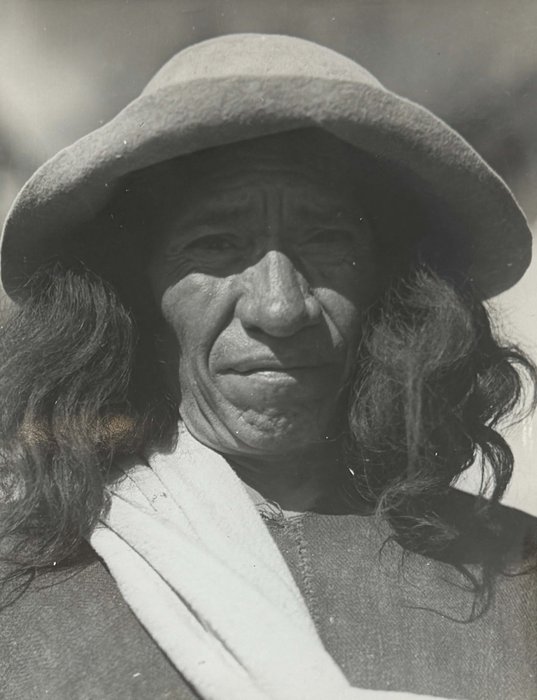
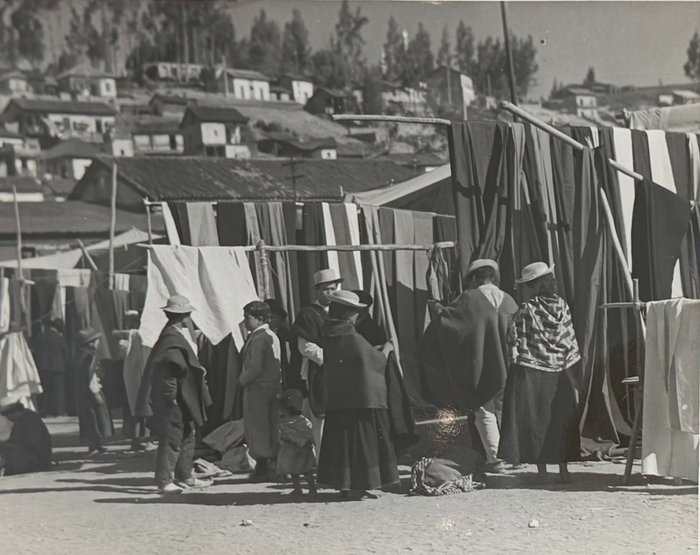
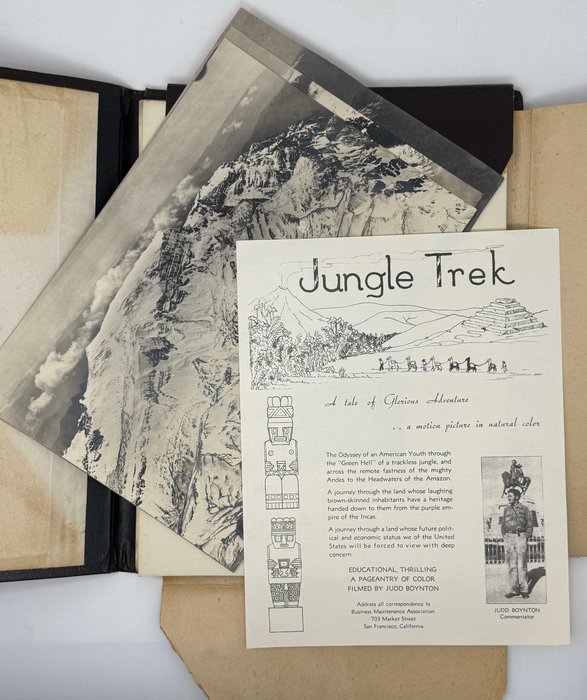
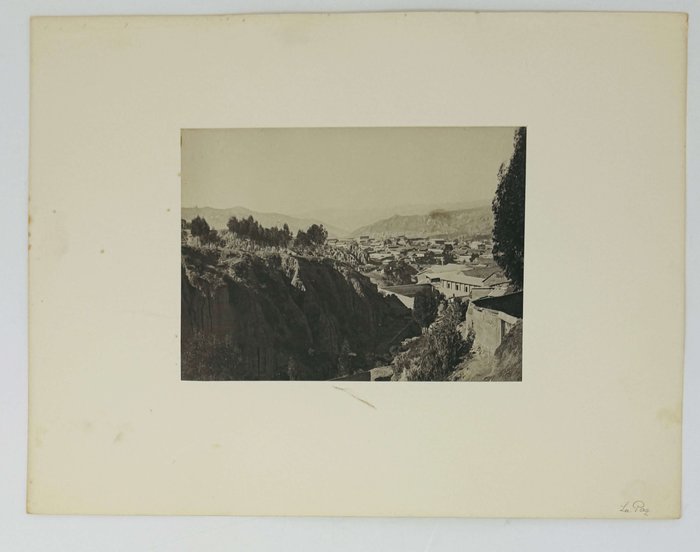
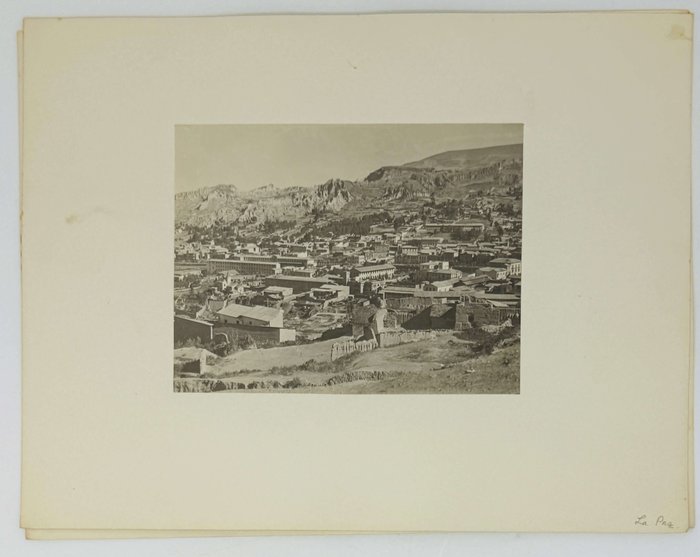
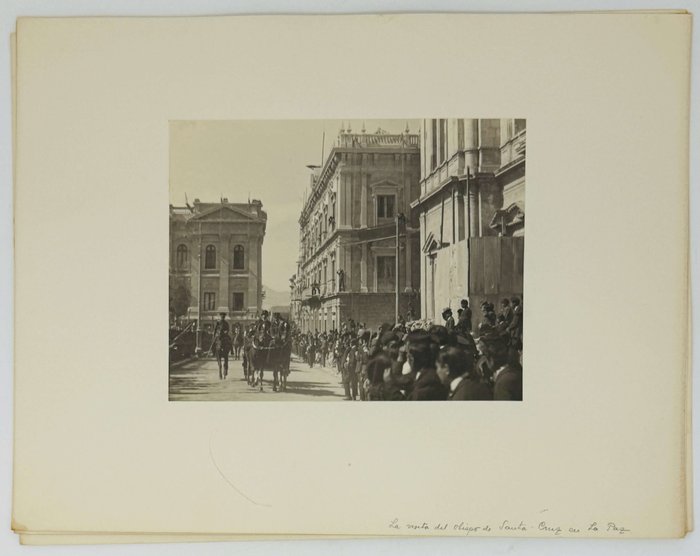
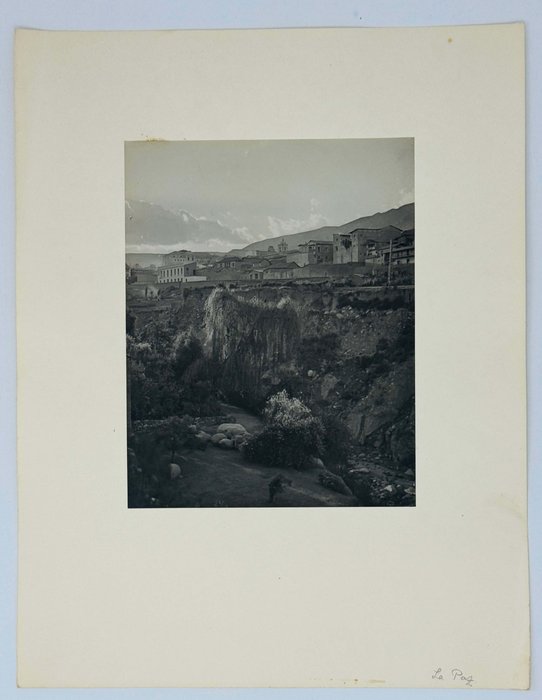

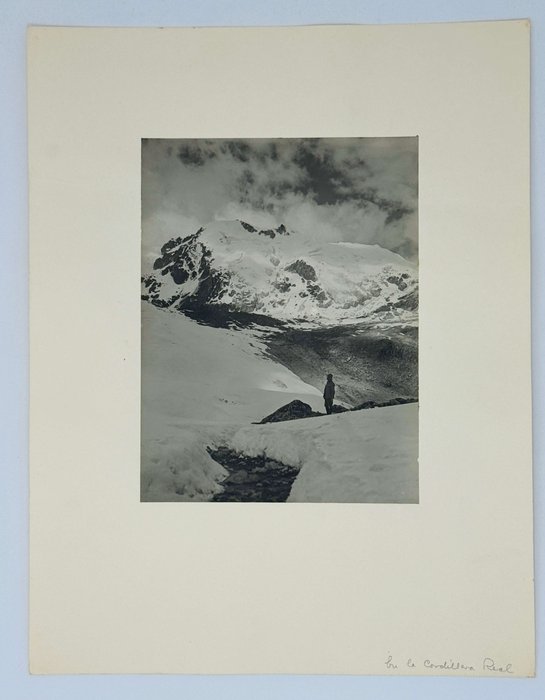
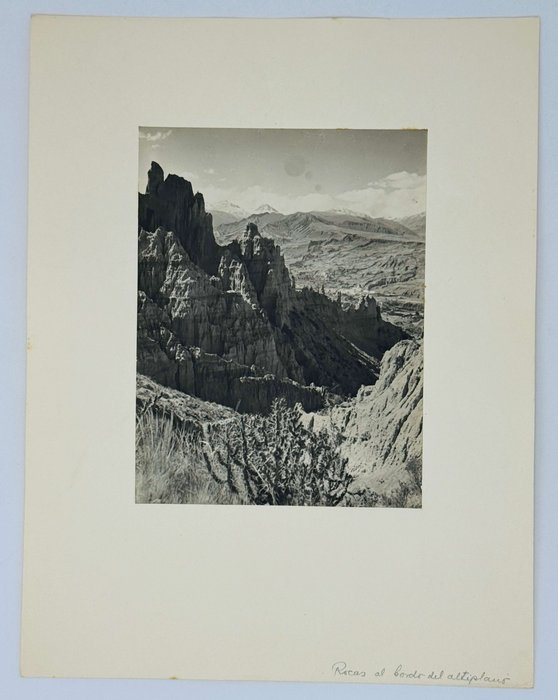
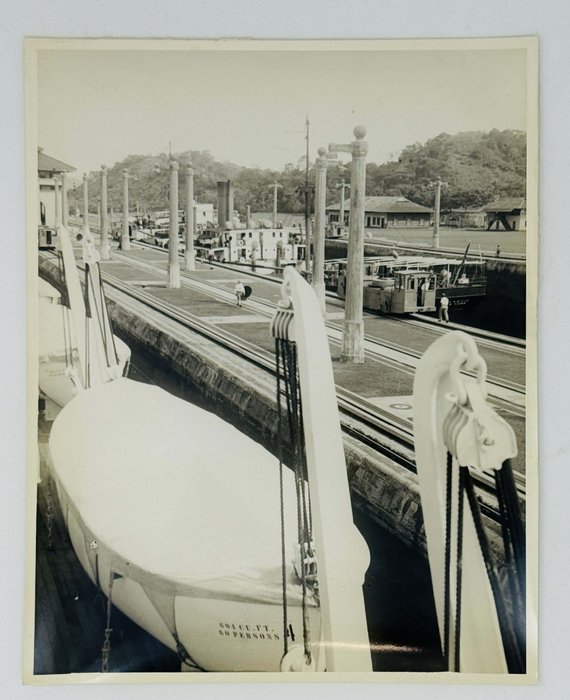
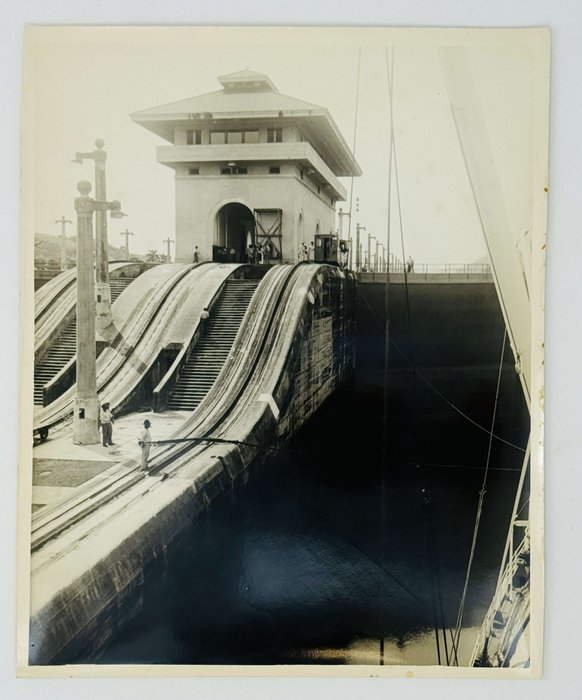
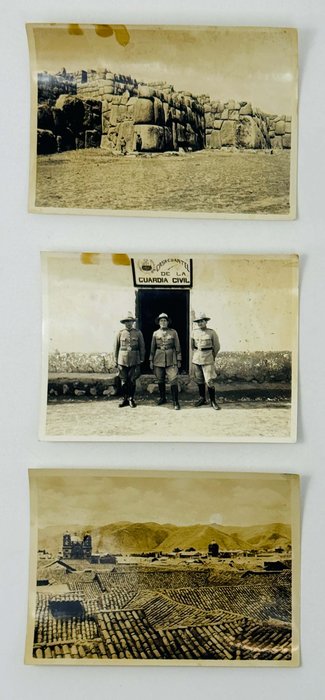
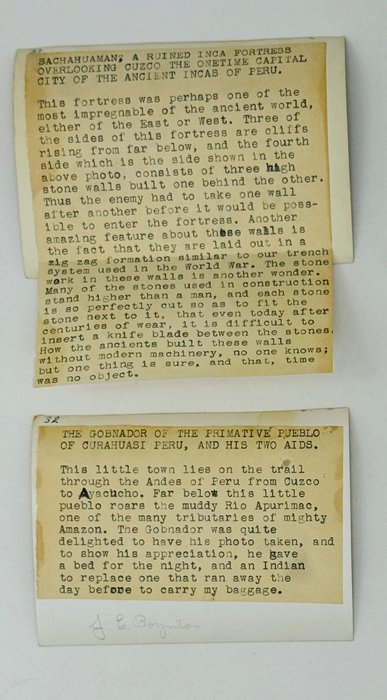
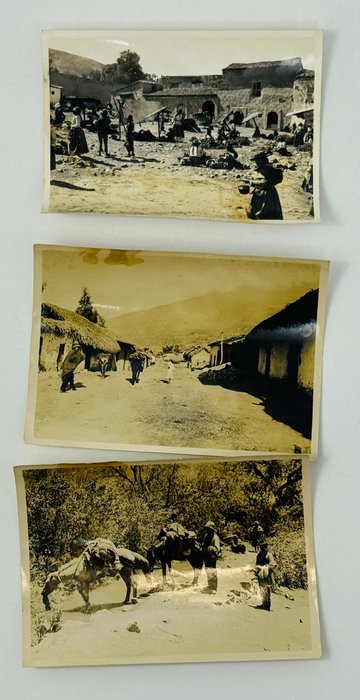
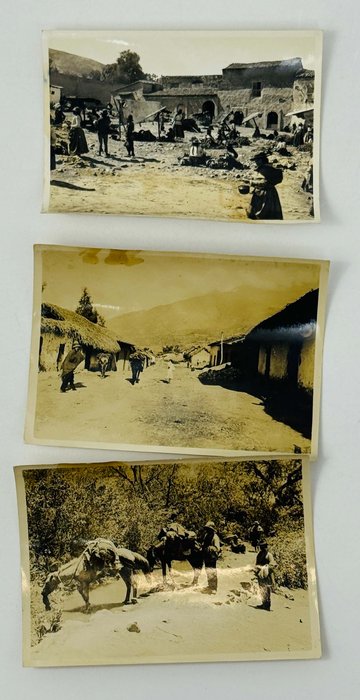
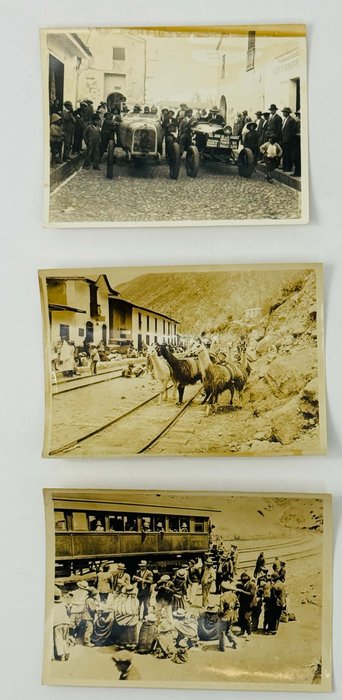
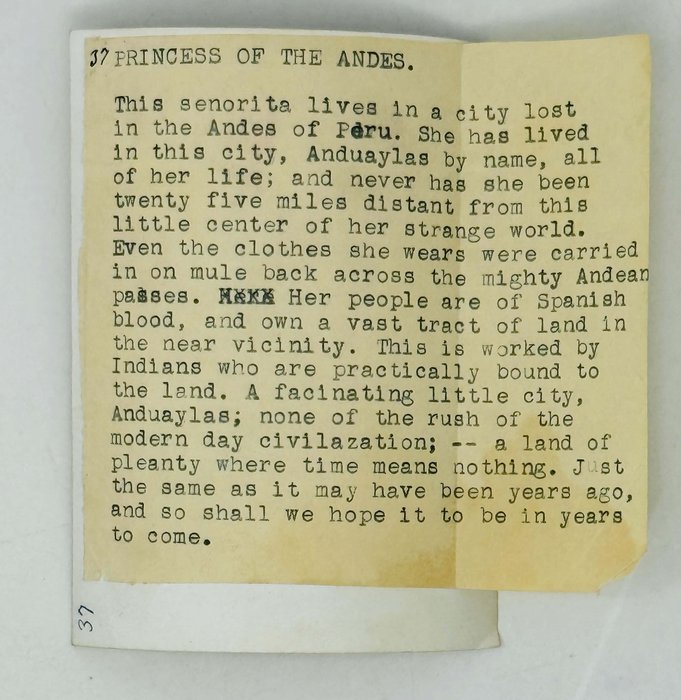
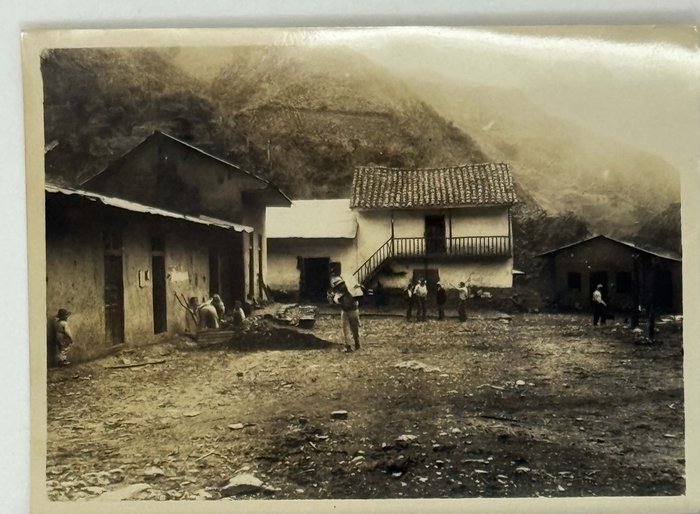
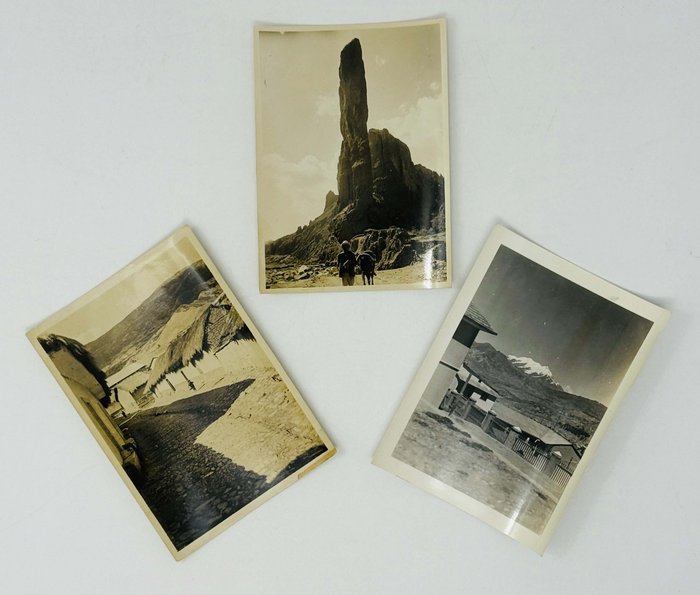
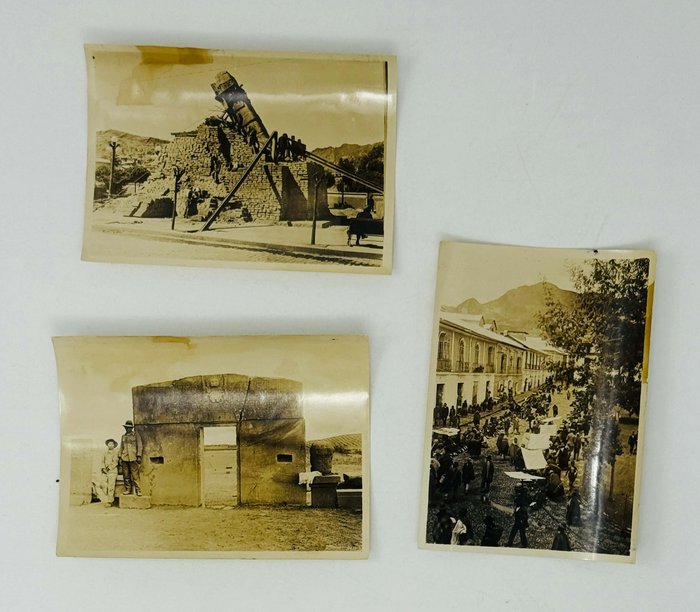
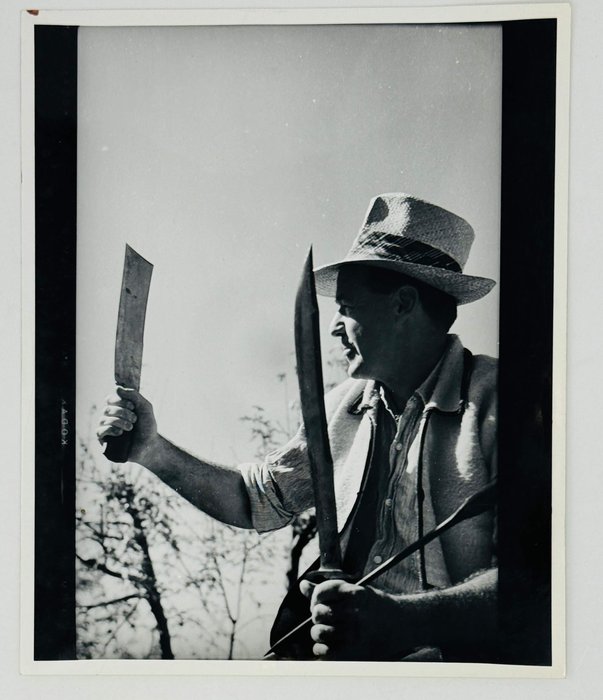
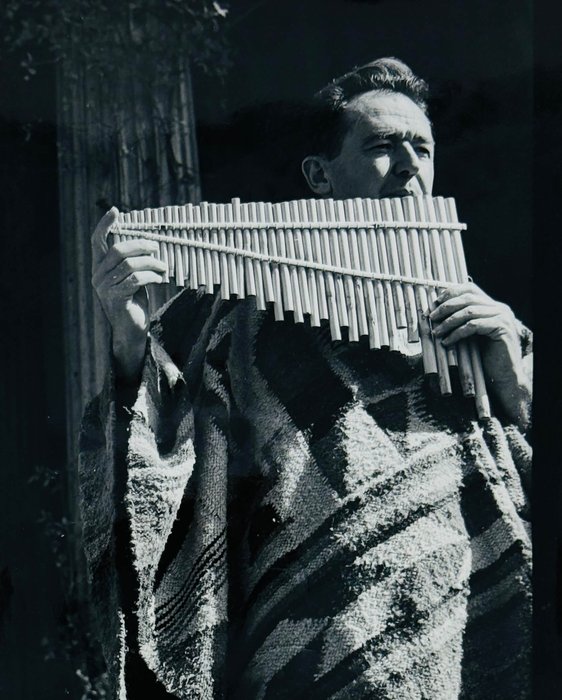
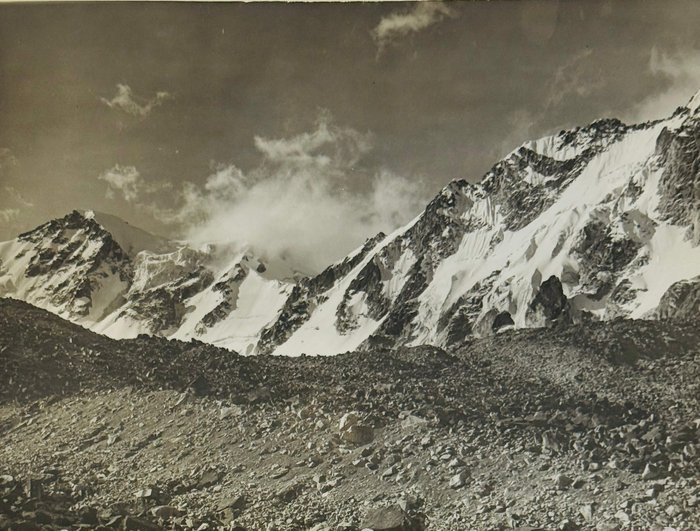
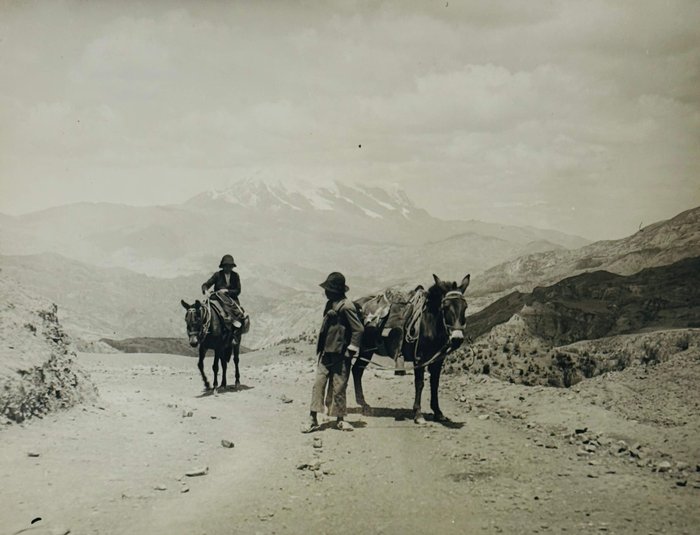

#PE99
Ca. 1930s
Ca. 180 loose original gelatin silver photos, including:
22 images (one in colour) from ca. 14x19 cm (5 ½ x 7 ½ in) to ca. 12x16 cm (4 ¾ x 6 ¼ in), each mounted on a loose album leaf ca. 25x32 cm (9 ¾ x 12 ¾ in); all with period pencil captions in Spanish on the mounts. All housed in a period brown faux leather folder ca. 34x27 cm (13 ¼ x 10 ½ in).
3 panoramas from ca. 21,5x32,5 cm (8 ½ x 12 ¾ in) to ca. 21x30 cm (8 ¼ x 11 ½ in), one photo with an ink stamp “Lloyd Aereo Boliviano, Aerofotogrametria” on verso.
87 smaller photos mostly ca. 8,5x11,5 cm (3 ¼ x 4 ½ in); ca. 70 photos with Boynton’s name written in ink or pencil, or ink stamps “Photo by Judd Emery Boynton” on verso; 42 photos with paper labels with typewritten captions (including a number of extensive texts) pasted on verso; over twenty photos with blank ink captions on verso; one photo with period ink stamps “Oct. 1933” on verso.
68 large photos, from ca. 21x27 cm (8 ¼ x 10 ½ in) to ca. 12,5x17,5 cm (5x7 in) or slightly smaller; over twenty photos with period pencil captions on verso. One photo with a blind stamp “Martin J. Chambi, Cuzco” in the right lower corner; one photo with an ink stamp “Photo by Judd Emery Boynton” on verso; two photos with period ink stamps “Jeffrey Belcher, Commercial, Architectural Photography, Berkeley, Calif.” on verso.
With a loose printed leaflet ca. 27,5x21,5 cm (11 x 8 ½ in). Two photos with round holes on the lower margin (apparently, for a binding), a few photos with minor creases or mildly faded, a number of small photos slightly waved, but overall a very good collection of strong interesting photos.
Historically significant extensive collection of original gelatin silver photos of South America – mostly, Bolivia and Peru, taken and collected by a Berkeley architect, photographer and adventurer, Judd Emery Boynton, during his travels to the Peruvian and Bolivian Andes and the Amazonian jungle in the 1930s. A son of a noted Berkeley attorney Charles C. Boynton and his wife Florence (a friend and student of famous American choreographer and pioneer of modern contemporary dance, Isadora Duncan), Judd “was born at the temple-like family home known as “The Temple of the Wings,” but nicknamed “The Doughnut House” by local residents [2800 Buena Vista Way, a Berkely Landmark since 1992]. The family, which included seven children, dressed in togas and lived a life of simplicity, eating nuts, berries and fruit. After graduating from the University of California, Boynton explored the Andes and the Amazon River and later prospected for gold in the Mother Lode country. He wrote on architecture, astronomy and also authored a book of memoirs” (Obituaries. Judd Emery Boynton// The Berkeley Gazette. 19 August 1983, p. 5). In the 1920s, Judd Boynton went on several mountaineering trips in the Yosemite National Park, having climbed “most all of the peaks of note” (Anderson, R. In Yosemite// Merced (California) Sun-Star, 11 August 1933, p. 8), including Mt. Starr King and Half Dome without the used of cables, “iron eye bolts or similar contrivances” (Anderson, R. In Yosemite// Merced (California) Sun-Star, 24 July 1934, p. 2).
In the 1930s, Boynton took two trips to South America, visiting Ecuador, Peru and Bolivia, travelling to the headwaters of the Amazon, “mule packing through the Andes” (Explorer to Speak at Club// The Oakland Post-Enquirer. 4 November 1936, p. 10), going across Lake Titicaca, visiting La Paz, and mountaineering in the Bolivian Andes (Anderson, R. In Yosemite// Merced (California) Sun-Star, 11 August 1933, p. 8), &c.
The collection includes over fifty and over twenty unique snapshot photos of Bolivia and Peru, evidently taken by Boynton during the same trip. Over forty photos are numbered and have paper labels with typewritten captions (often extensive, with notes on the history and geography of the sites) on the verso.
The photos of Bolivia show the scene of “erecting a monolith in the Prado of La Paz” (from “Tiahuanoco”/Tiwanaku Pre-Columbian archaeological site), “one of the lost canyons of Bolivia” (Palca Canyon), local pueblos/towns (“Palka,” “Sorata,” and others), “a typical finca (farm) in the Andes of Bolivia,” a group of “Bolivian recruits for the war in the Chaco” [the Chaco War, 1932-1935] a series of views of Bolivian Andes (Mt. Huayna Potosi, peaks, glaciers, roads, “an Ayamara shrine at the foot of the Charquini Glacier,” “continental divide of South America”), the Andean Plateau south of Lake Titicaca, Tiwanaku site (“in the ancient ruined city of Tiahuanoco,” “doorway of the Sun” in Tiahuanoco, Fraile monolith), “Ollanta” steamship on Lake Titicaca, La Paz (equestrian statue of Simon Bolivar, Paceo el Prado, rooftop view), Mount Illimani, local farmers and their fields, &c.
The smaller photos of Peru show Cuzco (Plaza de Armas with the Cathedral Basilica, rooftop views, street scenes, general views taken from above), ruins of the Inca Sacsayhuaman citadel, Rio Pampas, the cities of Abancay (the valley of Abancay taken from above, a street view), Ayacucho (market place, two cars on “an automobile race in the high Andes of Peru”), and Mejorada (llamas at the railway station), “the highest station on the main line of the highest railway in the world,” “an ancient fortress lost in the Andes of Peru,” the site of the Battle of Ayacucho, portraits of “the Gobnador of the Pueblo of Curahuasi Peru, and his two aids” and “princess of the Andes” from “Anduaylas” (Andahuaylas), &c.
The large photos of Peru include a series of sixteen excellent views of Machu Picchu (staircases, terraces, dwellings) and Cuzco (panoramic view, Central plaza, the Cathedral and Belfry, Inca masonry, a detail of the Temple of the Moon, Inca Ruins in Pisac, Tambomachay and Sacsayhuaman), as well as photos of a steam engine of “Ferrocarril Central Andino” (sign “F.C.C.” on the side) with snow-capped Andean peaks in the background, and the Crypt of Heroes monument on the General Cemetery of Lima, “where Sancha Serro is buried” [Luis Miguel Sanches Cerro, 41st President of Peru in 1931-1933]. The collection also includes over a dozen larger copies of the smaller Bolivian and Peruvian photos.
Very interesting is the folder with twenty-two photos of Bolivia, showing La Paz and environs (general views taken from the distance and above, a scene taken during a visit of the Bishop of Santa Cruz to the city, entrance to the Basilica of San Francisco, Plaza Murillo), valleys and settlements in the Bolivian Yungas, a herd of llamas on the Altiplano (Andean Plateau), Mount Illimani, Cordillera Real mountain range, &c. Three large loose panoramas of high Andean peaks were evidently taken in the Bolivian Andes (one of them bears an ink stamp “Lloyd Aereo Boliviano, Aerofotogrametria” on verso).
The collection also includes twenty-two large views of Ecuador, seven of which were reproduced in the “Oregon Daily Journal” to illustrate a material about Boynton’s travels (Across the Andes on Forty Dollars// The Oregon Daily Journal, 28 November 1937, p. 56; see more). The reproduced images show Mount Chimborazo, a street of adobe houses in Ambato – “entrance to the headwaters of Amazon” (caption on verso), scenes with a donkey pulling an oil barrel and native workers loading bananas onto a steamship in Guayaquil, and portraits of a ”woman of the Otovalo Indians, who still speak Ketchue, old language of the Incas,” “Chief Huazcar, <…> of remote tribe in Andes” (caption on verso) and “an Albino Indian child, as white as snow.” Other photos of Equador show Quito (Basilica and Convent of San Francisco - with a smaller copy, men clearing the arena “after the bull fight”), the Church of San Francisco in Guayaquil, a market in Ambato, “farming in Andes,” “Indian grass huts,” jungle forest, native women and children, a group of men next to a railcar with the sign “G.&Q. R.” (“Guayaquil & Quito Railway”), &c.
There are also four large interesting photos of Panama Canal locks and watercourse (with three small copies). The collection contains several photo portraits of Judd Boyton – posing next to Simon Bolivar monument, mounted on a horse in a South American courtyard, playing a traditional pan flute (likely Peruvian) while wearing a poncho, &c.
A printed leaflet titled “Jungle Trek” and advertising Boynton’s documentary about his travels “through the ‘Green Hell’ of a trackless jungle, and across the remote fastness of the mighty Andes to the Headwaters of the Amazon,” is illustrated with a reproduction of his portrait in front of Simon Bolivar’s monument (the original is included in the collection).
Overall a unique, extensive important collection of original photographs of Bolivia, Peru and Ecuador, taken and assembled by a noted Californian mountaineer and adventurer in the 1930s.

